Don't wanna be here? Send us removal request.
Text
How to Run A Sub 2:40 Marathon
About ten months ago I ran my first standalone marathon, achieving a BQ time at 2:57. Then I ran my second standalone marathon last April in Boston, and PR’ed at 2:43. Yesterday, I ran my third and PR’d, this time at 2:39.
At some point around mile twenty, and I was in cruise control here, it dawned on me I’ve cut a sub-3 marathon time by twenty minutes in about ten months. So that’s extremely cool.
I don’t have a running background at all, but at some point over the last year something told me to keep pushing on this, see where I could really end up. My mara times are still well off anything truly competitive, but they’re also in the universe for the first time, too. And actual runners along the way, you know people who are actually good and who have done this for a long time, have pushed me to explore it more. That these trim-downs this quickly aren’t typical. I hear that, and it’s like dousing gasoline over a fire. So I’m going to see how much lower I can take this. Remember, I’m really old. An Old, as they say.
But I can answer the subject < 2:40 question in one sentence: it’s about discipline. Yes you need some natural talent to go this fast, but if you think motivation will be perpetual, I promise you will learn differently. The further you get into training the easier it is to become unmotivated.
But by that time, you’re usually increasingly disciplined. Not getting mileage in, not spending time in the gym feels weird. It feels undisciplined. It feels like you’re not checking a box you do as part of your every day.
Build disciplined training. How fast you go, how long you go, what you eat, all of those questions are important — but they are secondary. Get on your feet and get moving.
The Race: Utah Valley
So, anyone who has a chance to run this race should do it. The scenery is top-top, running past Deer Creek State Park, historic downtown Provo, and the like. It felt like I was running through Yellowstone at times. Badass.
The race is competitive (2:39 was 13OV), and it invites faster runners by nature due to its BQ status and fast downhill. Some random chronological notes from the race:
Pre-race training was mostly maintenance from Boston end of April until now. Six weeks isn’t enough time to make real gains, but you definitely can get hurt, so I tried out some longer, slower runs this time around. (For context, that was about 215mi in May.) I also knew that a 2:43 on a tougher Boston course asked the question of what my real PR target/time currently was, so I wanted to go under at minimum.
For the first time in an event, I did not go chicken and rice (to be clear this is just my favorite meal by a mile and just so happens to work well for marathons), and went pasta with Chicken Parmesan. This was a bit regrettable as I burped non-stop for the first ten miles or so. That said, legs energy-wise felt great! Morning of, went with the best pre-training food there is, stinger waffles. With a little peanut butter toast.
Still dealing with popliteus tendinopathy. Mostly pain management at this point, not as bad as it was in March, but I haven’t taken any rest time and don’t plan to. The one thing that sucked is this sort of downhill run puts extra stress on core (and different) muscles in your leg, and behind the knees is no exception.
Another reason I strongly recommend the race, beyond the scenery: setup and volunteers and fans were awesome. 9.5/10. And anyone who has ran a race of any kind know that’s a tailwind for you.
I opened up the race with a plan of running neutral or close-to-neutral splits, figuring a 1:18 was more than doable for the first-half, and a 1:19 or so doable for the second half.
That 1:18 number was on the softer side, especially because I opened up sustaining a 5:50/mi or so for a while and felt good. Until …
Mile 12! The choice was let my stomach explode from pee or pull out for a minute and hit the bathroom. This cost me close to a full minute on my total time, annoyingly.
Again, I made two general observations. There were many “better” runners in the field than me, but distance has a funny way of neutralizing things. You can only go so fast for so long and I’ve realized that what makes me competitive is I really don’t get tired. Maybe that’s good pace management, maybe it’s a testament to the endurance training and cross-training I do. Probably both. But again, I ended up passing a lot of sub-3 type runners from miles 17-24 or so.
Which, let me be clear: the 20-mile mark is notable for a reason. I don’t care how fast you are or what shape you’re in, your legs start really fatiguing here. A lot of the last 6-miles comes down to the amount of time on feet you’ve spent during training, and any injuries you may be dealing with.
i ended up finishing a little outside of the money, which sucked, but this is also something I could not have ever fathomed or imagined saying … fifteen months ago? Twelve months ago?
Got to meet some extremely nice people, always worth mentioning. Rode the bus up with the winner Tegene Fikadu — nice guy, built very differently from the rest of us, from Kenya I believe. Breathtaking speed. Also another reminder I need to drop about fifteen more pounds if I really want to leg down. (Problem there, already 2.9 BF, so I’m up against a wall of sorts there.)
I still prefer flat to flat/slightly downhill runs. The rolling hills are brutal; so too are unrelenting downhills on slopes highways. Legs just take a beating. Sometimes think it’s not worth the -5s or whatever.
One random funny-but-true thing: when you’re pacing 6-ish over this type distance, you become so acutely aware of even just a handful of seconds. A 5:55 pace versus a 6:02 pace feels very, very differently. Meanwhile, a 7:25 pace vs a 7:32 pace, still very good mile times, can feel identical.
Stats

Splits (5:42 lo)



As always, a special thanks to the friends and family who have helped me along the way.
1 note
·
View note
Text
163 Minutes in Boston

Follow on Strava
So about fifteen months ago, I signed up for my first 140mi Ironman. And then I trained a ton for it, and wrote about it. All-time experience.
But I got hurt during the early parts of the run and sort of slogged through it. And that just ate me alive, especially since (a) it was my first true marathon; and (b) I'm a much better runner than swimmer or cycler by nature.
That week I set a goal to qualify for Boston, and ran my second marathon in Utah, and qualified at 2:57, and wrote about what I did to run a sub-three. And you guys really liked that.
So let's talk about the Boston Marathon, which I ran over the weekend! I'll cut to the chase first -- the title was the giveaway, finishing 2:43 and 870th in my third (second?) full distance marathon.
For a fake runner, I was [mostly] happy. More on that later. Notes, race day details, and stats/splits to follow.
Training and Random Notes
On the plus-side of things, my training has been limit up over the last 12-months. Fitness levels, not a problem. Not at all. I do a lot more cross-training than most pure runners, which has it's benefits and drawbacks. But using Garmin's Intensity Minutes as a proxy, you can see how much we moved this needle up in recent months:

(That VO2 MAX is ripping ....)
On the minus-side of things, mostly everything else, at least for this race.
The worst winter (ever, and I mean EVER) in the Western United States. Running volume down as a result. Endless snow, frigid temperatures, and it's still going on.
An injury, which I've been lucky to avoid for a long while now. Twitter (TWITTER!) diagnosed the injury accurately -- popliteus tendinopathy, rare for most people, more common in runners and triathletes. Physical therapy affirmed. Lot of strength and mobility work, and we eventually went from 'sharpshooting pain' and 'aborted runs' in February to 'manageable'. It hasn't improved much beyond manageable. This also took running down some bit further on top of just horrific weather.
Generally speaking, I ran only about 30-40 miles a week during this 'down period', and in some weeks fewer than that. You can see how much I took it down (measured in mins)"

But I was religious about time on feet and cross-training. And those stairs. We kept on those stairs. More on that in a minute.
Race Morning Thoughts
Initially, I set a goal for 2:50:00. I knew that was a sandbagged number relative to my fitness, but I had concerns that my leg would hold up at the tail end of the race (especially in the infamous hills of Boston). Moreover, the weather was horrific. Just comical. The northeast has had the most pleasant winter in the history of mankind, and in typical April-in-New-England fashion, the marathon turned into intermittent monsoons and a sustained headwind. This was in the forecast in advance, and so I figured considering the factors at play.
I said I was bullish on fitness, but I was also bullish on nutrition. There are a lot of people I've learned who struggle (and struggle immensely with this) -- finnicky stomachs, indecisiveness, whatever. I train very early in the mornings and as soon as I'm done, it's one of my two jobs on deck, so breakfast is usually just a shake. That said: I tail-end eat a lot. I cannot remember the last day (in months) that I have not had at least two dinners. Eating so much late at night has it's drawbacks, but my body has grown well accustomed to storing and using for tomorrow morning's abuse. If you follow on Strava, you know there are a lot of hours in those early morning banks, and usually at harder intensities.
On that nutrition point: I really didn't have to overthink it much, because my caloric burn (~ 2.6k, let's call it) was only about 36 pct more burn than the average training day. Which isn't insignificant! But I imagine people who do not have heavy and sustained volumes have to get much more careful with loading 48-hours out from race, 24-hours out from race, etc.
With a relatively full stomach from the night prior, morning was easy: bagel and cream cheese, granola, honey stinger waffles (the GOAT of pre-workout food), and fluids.
Changed up the shoes this time around. I'm a firm believer in Nike for speed and HOKA for training/comfort. I usually race in Vapors, PR'd a 1/2 back on 9/11 in D.C (1:16). But it was in a monsoon, logged out the shoes something bad. So I went for the Alphas this time around. If you don't have a pair of Alphas, go get one. Worth it.
The Race
For anyone who is ever interested in running Boston, let me tell you a few quick things. One, it's a lifetime experience, full stop, it's not marketing and it's very real. Two, it's extremely secure, owing to previous events. Three, because it's extremely secure, it can feel cumbersome at times. Waiting around in Athletes Village for hours in cold weather and rain, with little to no cover -- not ideal. But everyone was in good spirits and by and large just trying to stay warm.
My qual time was good enough for wave one, but the congestion for the first five miles was insane. You really were running elbow-to-elbow for some bit of time. I stuck to the sides to try and at least hold a respectable pace (6:30 range) until it could thin out some.
The weather was a challenge the entire race. The cool temperatures kept the heart rate down (I only averaged 165 for the race, despite pushing some), but the sustained 20-25 mph headwind and intermittent heavy rain was a problem, and slowed the race considerably.
At the halfway mark, I was 1:19 range (tracker had 1:20 -- I of course ran more distance than needed, weaving in/out of crowds a few times). Still had full energy at this point, though my right knee was starting to bother a bit. At any rate, I knew I could carry this pace through the rest of the race, more or less.
The areas where the crowds are in Boston? Second to none. The energy is real. Really real. If you have music on, you won't hear it. And you don't want to hear it. Just a truly amazing experience and so laudable for the city -- these people want to motivate every runner, and man you get juiced up from it.
Take your pick: I either thought the hills around miles 16-20 were a bit overrated, certainly more of a mental challenge than anything. I don't say this as a running snob (I'm a fake runner, remember), I do say this as someone who swears by stairs and incline work. In every one of these races I seem to make up considerable time on comparable runners when going uphill. And though my pace grinded down expectedly climbing the hills, it was very comfortable and I didn't want to push my knee (now starting to bother a fair bit) to the point of no return. I trimmed my pace by about 20-25s in the last few miles for this reason. Pure fitness wise, I do think I could've held up the ~ 6:10 pace for about 33 to 35-miles or so, give or take. I do think I missed a couple of opportunities around miles 7-11 to gap down more aggressively, lesson learned there.
I ended 2:43. A bit disappointed to be blunt. I think with a healthy right leg, or better wx conditions, I could've given 2:39:59 a real run.
Most importantly: critical advertising for the worldwide leader. Go Bills.

Time for the next test. I left a lot on the table, and it's already bothering me!
Splits and Stats


2 notes
·
View notes
Text
Boston! (How to Run a Sub-3 Marathon)
Background
So at some point in the middle of training for a 140.6 Ironman, a couple of people noticed my running times and said something to the effect of, “hey, ya know you could probably qualify with Boston with a little training!”
When I trained for a full IM, I wanted to accomplish something extraordinarily difficult -- something that would take a lot of time and effort and dedication, and see what the end result would look like. Completing it was a real life accomplishment, especially for an average swimmer and a weak cyclist like myself. But I’ve always been a pretty good runner. More fast twitch than endurance, but pretty good nonetheless. At IM, I got injured around mile five, and ‘catching up’ during the running split became ‘complete the race’ in rapid fashion.
Anyways. After completing IM, I figured a few things. One, I’m drawn to endurance sports like a moth and flame. Two, I was in ridiculous shape, thanks to hundreds (and hundreds) of hours of training. Three, I wanted to complete another challenge. But what’s harder than completing an IM? Very few things, considering the length of the event. So I figured I’d have to find a midpoint -- an endurance event with a blistering target. A real race for time.
Fun fact, I’ve ran a bunch of half marathons before, but my first full marathon was the limping through the Woodlands at IM. I figured I was in good enough shape to be able to finish a marathon with a reasonable time, and with some head-down training, could do something really difficult. Like qualify for Boston.
And that’s when those few comments from a few month back became reality. For my age group, male 18-34 (I turn 34 in March), I would need to run a sub-3 marathon, effectively hold a 6:50/mile split throughout a 26.2 miler. The time threshold for this age group has been lowered (and lowered) as popularity of the event has grown, so the bar to clear was high.
Training
There are endless marathon training programs out there, and endless great advice. No matter what program you are looking at, volume is critical. I didn’t see any serious marathon programs that demanded any less than 40-miles a week, even for semi-experienced runners. Most marathon programs can range from 50 to 75-miles (or more) on a weekly basis. And, with that amount of volume, most of the training is about building your aerobic base. That means learning to run while keeping your heart rate low, and doing these slower-pace runs, over and over, and over and over, and over and over ...
I was in a unique position, though. One, I was a semi-experienced runner. Two, my aerobic base was, because of the April IM, exceptionally good. Three, I didn’t have a ‘run a marathon’ or ‘run a marathon relatively fast’ goal. My goal was to run 26.2, and to do it really fast.
Ultimately, what I ended up doing was about 40-miles a week (rarely more), and some weeks closer to 35-miles a week, for about 10-weeks. With a couple of notable exceptions:
- I completed a lot more zone 4 running than the average program would dictate. This would mean something between 8-11 miles, something around a 6:10 to 6:45 pace, and doing this at least once or twice a week. Most programs recommend against doing this to some degree because of heightened chance of injury (true), as well as the need to run more volume. But I needed to go fast, less so build my base. Working backwards a bit.
- To be clear, I would’ve had a better time with more training volume. But I’m cross-training a ton -- I’m working out something around 11-12 times a week, probably about 14-hours/week, with moderately heavy lifting and cross-training (swimming, a little bit of biking, and the stairs) intermixed. So while I didn’t have optimal running volume, I was training a ton.
- PS: the stairs are phenomenal cross-training for running. Do it on the day you don’t feel like running. Trust.
- My training program was about 10 or 11 weeks, though probably longer if you count all of the IM work. At any rate, most programs are 12 to 16 weeks, and quite frankly if you’re looking at doing one and running it well I recommend about 16-weeks to get it done.
- I’m a fast twitch athlete. So, running ‘fast’ came a little more natural to me than it migjht the average runner. But doing it for long periods of time would be the challenge.
A Key Lesson
I mentioned I’ve ran a bunch of half marathons. I’ve even won a couple. As a fast but very immature and inexperienced runner, I would frequently run positive splits -- blistering out of the gate, and rapidly returning to a baseline pace (or worse) and trying to hold on. By mile ten or whatever I’d be sucking wind; near the finish line of a half, I’d be glad it was over. As training progressed, I knew this wouldn’t be a realistic strategy for a full marathon. And moreover, listen to any serious runner (on YouTube or anywhere else you commonly look) and they’ll tell you the best approach is an even split (averaging roughly the same pace throughout the race) or a slightly negative split (your time improving as the race progresses). Negative splits, for immature runners like myself and just about everyone else, seem only theoretical, and hardly practical. But an even pace run, I figured, was doable. And I already knew my target pace: I had to hold a 6:50/mile, and no worse.
Finding a Race
There are lots of cool things about running (the benefits to physical/mental health are extraordinary and unrivaled; the cost to enter the sport is very low; etc.). and it’s become very, very popular over the years. Finding a race is as easy as finding crumbs on a wood floor. only certain races are considered Boston qualifiers, though, and so I sampled through a few before landing on the Deseret News Marathon in Salt Lake City, Utah.
Why this race? A few reasons. Getting there would be relatively easy. It’s a fast course, with an early downhill. It’s also gorgeous and scenic which never hurts. The negatives of the race were mitigated two ways -- summer heat wouldn’t factor with a 5:30 lcl start, and elevation wouldn’t impact me as much as others with where I was doing the majority of the training.
Gear
I did a lot of research on running shoes -- I had been training in some comfortable HOKAs and a couple of pair of cheaper Nikes, but wanted to look for a race shoe. I settled on the Nike ZoomX Vaporfly Next% 2. These shoes are ultra-light, plenty of comfort at the heel, and you really do feel a couple of seconds faster in them. There’s some research that indicates it makes runners more economic/efficient, maybe worth 1 per cent or so of your time. Without doing any more sales for Nike, I figured if they were good enough for Kipchoge, they were probably good enough for me.
And hey, placebo effect, worst case scenario. Beauties:

I will say I took these out for a couple of spins before the race. You shouldn’t train in shoes like this, but they do feel different. and I’d caution against racing in anything for the first time.
Other than that, simple cutoff and running shorts with compression under. Easy.
Nutrition
This is an area where I have the benefit of the doubt over a lot of others, because in IM, if you don’t have your nutrition down, it is inevitable you will fail. And, by the way, I was teetering on failure during IM. I knew that at this pace and at my body weight, I would have to consume anywhere from 280 - 440 calories for glycogen replenishment.
And let me be clear, this is essential, whether you are running at a fast pace or running for your PR or just running to finish. All of the nutritional carb-loading type of stuff you do in the days leading up to a race is great for your muscles, but you need to satisfy your liver during the race, or you run the risk of bonking, The way I think of it is this: the pasta and bread you’re having a few days out is going to get maximally stored in your legs, and the nutrition you take during the race is mostly for your brain.
But bonking is a real risk. You do not want to be upside down on your nutrition. You could be two miles out from a PR and end with a DNF if you break down this way. Don’t do it. Get your nutrition down.
For the race, I used CLIF SHOT Energy gels. Very similar to Gu, but Gu based on experience would turn my stomach by the third or fourth iteration. So, I went a slightly different route. Otherwise, it was water for the first twenty miles, with a little gatorade during mile twenty.
Race Day Nutrition
I knew any sort of glcyogen deficiency would guarantee a > 3:00:00 finish, so I ate a little bit more than the average person the morning thereof. I think the key is the time from eating until the time to race -- I had already consumed my breakfast by 2:30 lcl, giving me three hours to digest what I had. And even though I’m a relatively lighter bw now, it was a decent array: a protein bar, two honey stinger waffles, toast and peanut butter.
I’d rather a turning stomach than cramps or a bonk. I could compartmentalize a turning stomach. I knew, in part from IM, your legs dying out was unrecoverable. (And it is. I cannot emphasize this enough.)
The Race
We launched at 5:30 lcl, my buddy Trent (who finished his first in 10-years on a bad knee at the age of 42 -- SUPER IMPRESSIVE!) joined me. Fun fact, five minutes before the gun, we realized I had lost my headphones. Silent run. Nice curveball. A ton of athletes out there -- plenty of different backgrounds, but an impressive group of people with a lot of athleticism. And boy, did lots of them make the same mistakes I used to in my (very limited) prior running events. That is: fast, too fast, early.
I ran mile one at 6:44, and verbalized ‘SIX’ after mile one, recognizing I had banked six seconds from my pace time. I did this for every mile going forward, cumulatively. Mile two? 6:44. ‘TWELVE’. And on and on. There must have been sixty or seventy runners ahead of me at mile three or four.
And from mile five on, I passed just about every single one of them -- on the list of ten who actually ended up finishing the race faster than me, all of them from what I could tell were collegiant cross country athletes, are collegiant cross country athletes, a couple of IM athletes, etc. I guess my point is this: these people are built differently. I’m average, like everyone else in the race. The difference between my averageness and everyone else’s averageness, I think, was I had a plan.
I watched as these runners, who came storming out of the gate, suck wind and fade. Mile five. Mile eight. Mile fifteen. I passed four or five elite runners, guys who were easily running 6:45 splits or so, at mile twenty. They were in tough shape.
Not me. Mile 16 was my fastest time. Then trumped by mile 17. Then mile 25, where I turned in a 6:35. I could have dumped a 6:00 in there -- that’s how great I felt. But I knew that every second above my true race pace was worth two seconds later on, and the risk of fatiguing out, especially late, is EXTRAORDINARY. So much of it was/is mental discipline. So I stayed discipline.
Anyways: 2:57 marathon, and qualified for Boston next April. I did it! (Also took first for my group; that was pretty cool since I’m old AF now.)

And two crazy parts about it:
- I ran about 0.2 or 0.3 miles longer than the race. A very friendly cop did a not-so-friendly thing and send me in the opposite direction at a turn around mile 23. What killed me is he did it with such confidence -- not like an ‘I’m not sure which way to turn’, more like ‘go this way’. A passerby let me know I was going the wrong way. I turned and stepped on the gas ...
- ... BECAUSE I COULD. At the end of the race, I’m certain I could’ve continued running at that 6:44 pace I held for another 5 or so miles. My energy levels were fine. More than anything else, I was impressed with this particular point. Why? Because almost all of the run was in zone four, hardly any in zone five, and I never got over my skis. At least I think that’s a huge part of it. Look at the consistency in the pace. This, as many smarter people will tell you, is key.

- ... but I’m not sure my right leg would’ve held up. One thing about downhill running (first five miles were well downhill) is that I really do think it’s a net-negative to flat-trail running. Yes, you move faster. But it wears and tears on your legs. And the course, beautiful as it was, had very tough gradients. So almost the entirely of the race was on the left side of sloped roads, and my right calf was taking an absolute beating. I tried to flow into the middle of the road where I could, but the opportunities didn’t present themselves much.
After the Race
My right leg is pretty sore, but I was able to workout today and did. Expect to keep it easy the following day though. My right calf did look as gnarly as I tried to articulate the pain was:

What’s Next?
Well, the Boston Marathon for sure. So I’ll train hard to push my time down for that. But I also want to keep challenging myself. I’m looking at an ultra, perhaps a 50K or 100K, in the future. And I’m going to take on another full IM, but this time better prepared -- both physically and nutritionally. Need to work more on the bike, no doubt about that. And I know I can shave some real time relative to the field when running, but I have to be able to hold up.
Special Thanks
To all of people in the running/IM/related athletic communities, and those of you on Twitter, who gave me a ton of great advice on a variety of things. From injury treatment to pace strategy to nutrition, I’ve found you can get help from so many gracious people if you just ask. So this is me trying to pay it back just a bit. Thank you all again!
Onto Boston, and plenty of more challenges ahead. Lastly, add me on Strava if your heart desires to follow: @yost_travis.
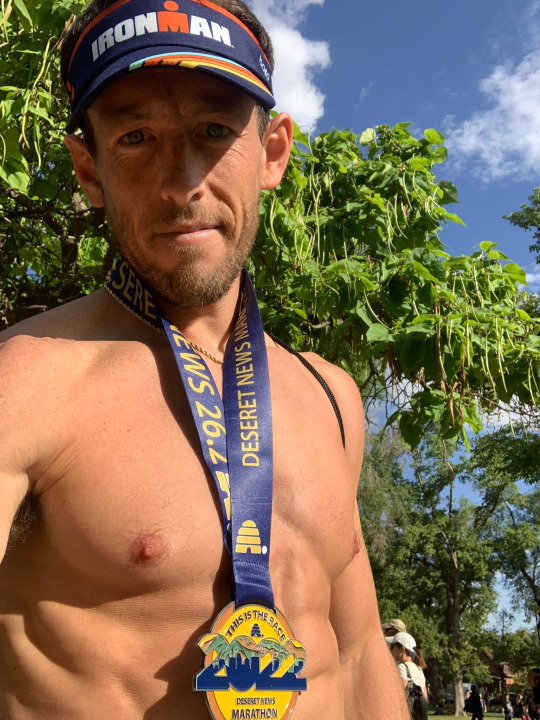
1 note
·
View note
Text
My Ironman Experience
So I completed an Ironman this weekend in the Woodlands, TX. Really, I did! Here’s photo evidence.

First time, and first first triathlon of any kind I’ve done. It was an incredible experience -- easily the most difficult thing I have ever done, but not necessarily for the reasons you would think. And that, I think, is part of the Ironman story.
A ton of you reached out to me over the last few months, publicly and privately, with great questions and general curiosity about what I was doing and how I was doing it. I promised a great deal of you a (probably overly lengthy) summary of what it was like training for it, what it was like racing, and what a triathlon experience in this environment is really like. So this is my best attempt, transparent as possible on the ups and downs!
What the fuck is an Ironman?
Let’s start here. The Ironman Triathlon is one of the long-distance triathlon races put on by the World Triathlon Corporation. It is a 2.4-mile swim, followed by a 112-mile bike, followed by a full marathon (140.6 mi total) -- they also have ‘half’ events which appear increasingly popular, with more pace/less total distance. It is an event that requires extreme endurance, but it is also an event that requires extreme performance -- Ironman is very particular about race segments and cutoff times.
Ironman has a ‘compete or complete’ mantra, which is one of the core tenets of the race. A small portion of the race (the professionals and a small subset of amateur racers) are truly competing to win the race, moving 140-miles at blistering, really unfathomable paces. The rest of the group is either focused on setting personal records or, quite simply, finishing the race. They’re all incredible achievements.
The race is extremely regulated (no comms devices, no headphones/music, very specific rules on aid, very specific rules on wet suit swims, tight cutoff times, et al.) It’s the beauty of it, and the pain of it.
Why would anyone do this?
I think this is one of the most interesting parts of the race. Setting aside the professionals for a moment, it’s clear that the core group of racers are exceptionally motivated by something or some things. You talk to people, and you hear the gamut: the biggest physical challenge of their lives, they’re navigating a crisis in their lives and this is a release valve, they’re doing it in memory of a friend or family member, they’re doing it for their own personal goals and conquests, and on and on and on.
None more important than the other. But if you don’t have something to be your north star, you will struggle, if not fail. That’s the simple reality.
My particular case was interesting. I wanted an extreme physical challenge, yes. But as the training opened up, my motivations were ‘colored in’, so to speak. I won’t go to into too much detail here, but for the people hurting in my orbit, I wanted to show them that anything was achievable, even with truly terrible odds. And then, I had a setback in my own personal health. Funny how life works out. I might have struggled if I hadn’t been training for this -- instead, it became just stronger motivation.
What background does it require?
It doesn’t require any background! That’s the beauty of it. Background goes to how long of a spool-up time you need for training, how much time you need to carve out to meet your individual mile-markers (be it your own plan or any of the myriad training plans offered) in order to have a successful race.
And everyone has a different background. I've stayed fit my whole life, I consider myself very athletic, and my endurance levels are through the roof. Great! Counterpoint: I had zero racing experience in any of the three events. And while I’m a very strong runner, I was a novice swimmer (I can swim and drink beers in your pool, yes) and a damn-near beginner cycler. And let me tell you, the technical challenges for me with the bike were significant for some time.
So, like everyone else, I had unique strengths and unique weaknesses.
What was training like?
One thing challenged me significantly with Ironman training, and that was available time. I work. I work a lot. I also spend a good amount of time in areas where cycling isn’t super-fun, be it from high winds or heavier traffic. Considering you spend (by far) the most amount of time on the bike, and considering it was my weakest of the three (also by far) heading into training, this was a problem.
Many people are spending 10-14 hours a week conducting Ironman training. There are endless programs out there so I won’t spend time on that. What I want to address is the human side of this.
I have worked out seven days a week, 29-30 days a month for as long as I can remember. I spend a lot of time in the gym or out running, it’s a release, and I enjoy it. But training for an event like this is different. Only so many times can you wake up at 430am to go for a 1.5 mile swim. Only so many times can you spin on a bike indoors, mindlessly, knowing you are going to do this (again) the next day, and the next day, and the next day.
And so Ironman training replaced my normal gym time, and it was somewhat seamless, but as I had to spend incrementally more time in the gym each week, it was (a) increasingly harder to find time; and (b) became a mental fight.
What mental fight?
Yes. Do you know how many times I sat in my car for fifteen, twenty minutes in front of the gym, mentally fighting whether I could make today an ‘off day’ or a ‘split day’ or something that just allowed me to get three tacos from Taco Bell and call it a day. Your body is tired, but your brain is tired too, and the repetitions are endless.
What was swim training like?
For me, not bad. I was a crappy swimmer but improved quite a bit just getting the appropriate equipment and focusing a ton on technicals. I became very mindful of breathing (I still can’t breathe bilaterally all that comfortably) and pacing. It ultimately comes down to ‘are you getting your reps in, or not?’ and if the answer is ‘not’, you are going to seize up on race day.
The downside to swimming: no headphones to kill the time during training. You can go out and buy underwaters, but I didn’t. Not sure if it would have helped. I generally kept training distances between 1,500 meters to 2,800 meters, with a few flex ups into 3,200 meter range. I never swam the full distance until race day, believe it or not, mostly because I was in a lap pool and you can only change off the wall so many times before you go insane.
What was bike training like?
If I had one ‘do-over’, it’s probably here. I spend a lot of time in areas not necessarily conducive to outdoor cycling. Consequently, I spent a lot of time training indoors, either on a bike on a trainer or just spinning. My endurance was through the roof by race week, but the technicals were still a bit shaky when it came to getting in the saddle, on a tri bike, with aero bars and paper-thin wheels. The goal is to go as fast as possible at all times, in the most aerodynamic way, while simultaneously taking a lot of nutrition.
A few months before the race I purchased a Kuota Kalibur tri bike from a former triathlon pro. Phenomenal bike, super fast, and about as far a cry as you can imagine from your teenage road bike as you could possibly imagine. This is before you get into the technical aspects of the sport -- from simple things like changing gears to changing your own tire on the side of the road.
But: I did not spend as much time in the saddle as I should have. More on this later.
What was run training like?
For me, easy. I enjoy running. So much so that I had to be mindful that running, although phenomenal for so many things, is also a magnet for injuries. And so when I would try to swap an extra running day in (at the cost of a swimming or bike segment), it usually meant more fatigue and more bumps/bruises.
What’s remarkable is how much progress I made here. With swimming or cycling, my baseline was pretty low. Not running. And yet my second-to-last training event, I ran 16-miles at a 6:50/mi pace. That’s flying. And it felt great, and I still had legs. (It was right after this run, by the way, that I had my ‘holy shit’ moment -- that I had taken the next leg up in performance in a considerable way, and it became rocket fuel for the final couple of weeks of training.
I will say that I think a decent number of Ironman competitors struggle here. (Funny enough, I did too on race day. More on that later.) There are plenty of cyclers transitioning to running, true, but running is also extremely unforgiving. You cannot run through some injuries. You cannot carry excess weight, not without a performance drag. And since it’s the last leg of the race, you will likely start the run at or near exhaustion. Very different than your early morning jog.
Random things you will surely need during training..
In no particular order:
- Incredible support/flexibility from loved ones - Big chunks of training time (most people either get up extremely early to fill this gap, or handle long rides/runs on weekends) - A deep wallet if you’re a first time competitor
The days before the race ...
Woodlands, Texas. Me and a buddy of mine flew in a couple of days early -- check-in and athlete briefings (required) usually happen a few days before the race. Packing for the race wasn’t so bad, with one extraordinary exception: the bike, if you have to fly.
We did, so that meant we had three options for the bike: - Break the entirety of the bike down into a ‘bike box’ and hope/pray it doesn’t get damaged during air transport - Buy a hard bike case and remove tangential items when packing (e.g. pedals/aero bars); if you don’t own one, this will cost you an arm and a leg - Send it via bike transportation services, which is seamless, and also will cost you two arms and two legs
I chose option two, it worked out fine, but a pretty royal pain in the ass. It is what it is.
Race day...
There’s no way around it, your adrenaline is going to be at absolute max. I was extremely cognizant of nutrition -- I ate a lot of bland food leading into the race, and I ate a PB&J sandwich (haven’t had one in 10+Y) race morning. Naturally, your fears start creeping in.
The weather outlook for the race was, quite frankly, abysmal. It was hot and humid, perhaps what you would expect in Texas, but that was much less of an issue than the winds that moved into the Houston area. 25-30 mph and routinely gusting to 40-45 mph crosswinds figured to have a serious impact on times and performance.
For me, my ‘mental’ gameplan was as follows:
- Finish the swim with a reasonable pace. A 1:40 swim or less would be awesome. A 1:30 swim or less would be heavenly. - Survive the bike. I was very confident in my endurance, not nearly as confident as my technical ability, but now knew that heavy winds were moving into the area. Since the bike was predominantly on a highway toll road (barren and uncovered), I threw my target bike time (which was on the low side already) at 6:20 to 6:30 to finish. - Pick up time on the run. I knew I would be tired and unable to hold my training paces during the race, but three days before the race, I felt like I was walking a 5-mile, 7:24 pace run. Like actually walking. If I had any energy left and wasn’t hurt, I knew I could really make up time here.
The swim..

It’s so easy to see how one can get intimidated getting into the water, especially for an open water swim. Thousands of people are entering the water just a few feet apart, launched in 4-6 people/4-6 seconds, and you are inevitably swimming on the top of one another. For some reason my nerves weren’t as jumpy as I thought here -- I think in part because I knew the bike would be so daunting.
I went with the 1:21 to 1:30 pace group, which was ambitious. and I absolutely crushed the swim. I cruised to a 1:22 finish, and I was flying the entire time. Quite frankly some of the time I lost here was because I either had to slow down with people around me or on top of me, or a couple of equipment corrections (a lady, in her swim, kicked the goggles off my head at one point -- it happens).
I paced myself early on, mentally second-guessing myself that I would burn out. But a number of you told me to ‘trust the training and trust the taper’ for a good reason. I didn’t burn out. My arms got heavy, but I was cutting through the water the same way the entire time. And because it was a wet suit eligible race, my legs were a bit more buoyant, helping avoid the ‘sinking legs’ problem that tends to creep into swims at longer distances.
My form didn’t break down. I was so proud getting out of the water because I knew I had exceeded my expectations by a lot. And, I knew my time was very competitive, especially for a novice-ish swimmer. Most importantly, I felt GREAT getting on the bike. Look at this!
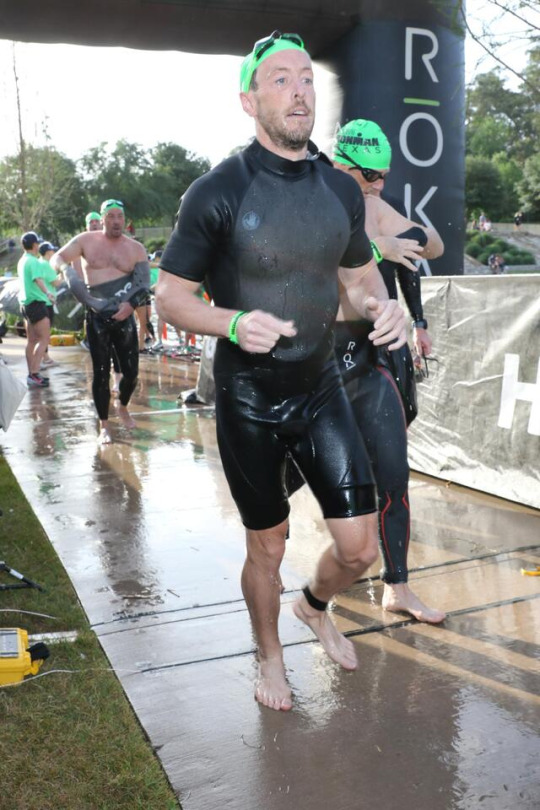
The bike...

The first twenty miles or so were in the suburban areas, which have much more cover and were insulated against the wind. I spent the early parts of the ride eating, rallying calories after a long swim. And I felt great on the bike. Was generating plenty of power, and I was generally sitting around the pace I wanted to be at (18.5 mph).

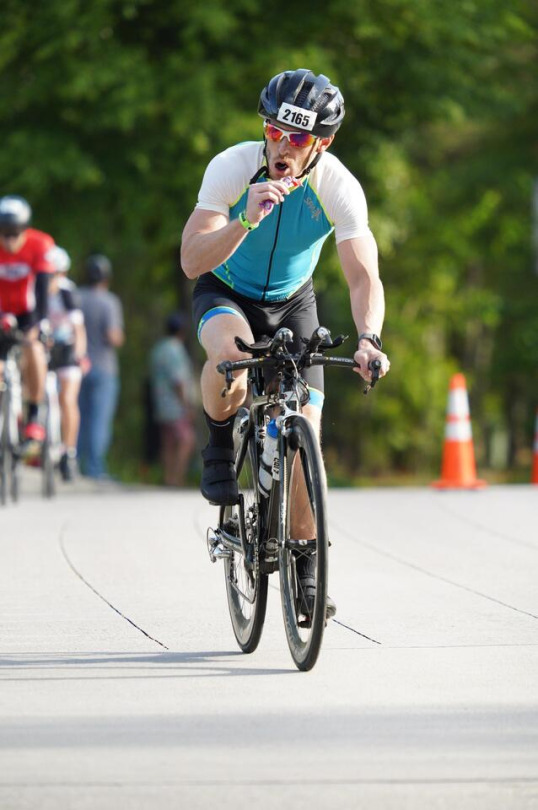
Then the highway circuit hit.
If you haven’t cycled in heavy cross-winds, it’s really hard to explain. You have to be technically perfect, as aero as you can be, or moving will be a giant struggle. And for me and everyone else, it was. The ride into the head/cross-winds, about 35-40 miles total, was the singlest hardest thing I have ever done in my life. My time was absolutely severed. At one point I finished a 10-mile lap at around 13 mph, which is truly pathetic. I felt like I was going backwards at some points. With the wind, I was pacing double, as you’d expect, but I was generally using the tailwinds to also ‘take breaks’ for periods of time.
Mentally I was zeroed, the only saving grace was watching just about everyone else struggle in the same manner. The more proficient riders had an easier time, yes, but they tended to recover on the tailwind part of the ride.
So, I got monkeyhammered on the bike. Badly. 6:40. I suspect most people did, because I believe the event coordinators extended the cutoff time to finish the rave due to comprehensively sagging bike times.
And yet when I got off the bike, I felt ... somewhat fresh? Perhaps even excited to win some time back on the run? It was 26-miles and I knew 2/3rds of that I could pace with vigor. And, the bike was such a bloodbath, I had energy stored.
The run...

I get off the bike, into the run transition, and I’m cruising. Legs feel good. My first mile was at a blistering pace, sub-6, but a lot of that was just getting rid of pent up energy. (Energy I couldn’t use on the bike because, you know, there was a cyclone over the highway.) I eased into a nice 8-minute pace and was cruising for a few miles. Cruising!
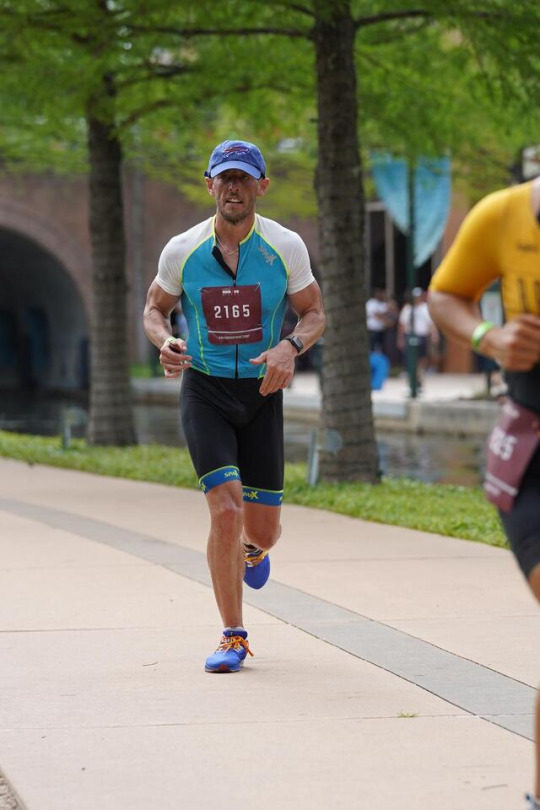
.. and then..
.. injury. Both of my legs start cramping, which wasn’t entirely unexpected, but my right calf balled up and actually felt like it rotated up behind my knee. Extreme cramp. The type of cramp you have to walk through. I was able to hold a slower jog for a few more miles as I tried to recover from the pain a bit, but another vicious rip at the right calf around mile 8/9 completely changed my mentality the rest of the race.
There would be no more making up time. It was either finish the race at a slower pace than you’d like, dump it and get seriously hurt, or walk. I chose option A.
And, that’s the irony in all of this, I think. You cannot predict what is going to happen in these races, be it conditions, health, whatever. I sandbagged my swim. My bike probably would have went MUCH better without wind (I was only 10-15 minutes off my expected pace and I didn’t move for miles!). And the run? The run, which I thought I would absolutely cruise through, turned out to be an extraordinary challenge, now on fumes and injured.
But I finished that shit! 13-hours on the dot. And it feels like one of my greatest accomplishments ever.


The injury on the run cost me dearly on the time (I’m guessing conservatively 30-minutes), but finishing my first race with a respectable time was so important to me, so I plowed through.
Which, by the way, is what you see everyone else doing: the amount of limping, walking, puking, whatever I saw on the run was absolutely extraordinary. These are the best athletes in the world and if you watched the tail end of the run, it looked like a bunch of drunks leaving a bar near Arizona State.
But that’s the race. It’s that hard. Comprehensively.
The community ...
I cannot, cannot, CANNOT explain how awesome this event was ran. It’s perfectly structured. There are hordes of volunteers. These volunteers make the race. They’ll pretty much do whatever they can within the confines of the race rules to assist you. I had a guy body slam me to the ground after my swim so he could yank my wet suit off in 10-seconds. It was incredible.
Volunteers made the race. The city and all of the attendees, thousands of them, cheering everyone on made the race. The police and fire teams deployed to the area made the race. It was so well run.
And most of all, the community. I have never seen in my life a more supporting, positive group of people. Everyone is cheering for everyone else. Everyone is supporting everyone else.
In 2022, that seems like an impossible thing to find. Not here.
1 note
·
View note
Text
The Numbers Are Always Improving. Just Ask Clay Travis.
You may have heard that there is a global pandemic. In the United States, the noval coronavirus has killed over 160,000 people.
Clay Travis has, for some reason, decided to become a coronavirus truther. He spends all day suggesting the situation is improving. It is disingenuous.
These updates come furiously and will always try to paint the reported numbers in the most favorable light possible. This commonly means -- among other things -- purposely highlighting Monday’s reporting numbers (commonly low due to weekend lags, which Clay Travis knows) as “low”. It also means oscillating between cases and deaths. Whichever the lower growth number of the two, well, that becomes the sign that the situation is getting better.
Take, for example, Clay’s interpretation of reported death counts since the early days of the original breakout and subsequent nursing home disaster in the Northeast. For a while it was about emphasizing that both case counts and death counts were down. As cases rose (dramatically) in the Southeast and Southwest, Clay moved away from the case discussion and towards a single point of measure in fatalities. Since the deaths aren’t there, he posited, there is nothing for anyone to worry about. Anyone who pointed out that the massive inherent risk with having 400,000+ new infections a calendar week would have on hospitals and, more specifically, human survival was called a coronabro. Still true to this day.
Having searched for approximately three minutes, I found at least thirty-five instances since June 1st -- once every other day, more or less -- in which Clay pointed out that country-wide deaths were down, trending favorably, or isolating on day-over-day data to push an improvement narrative:
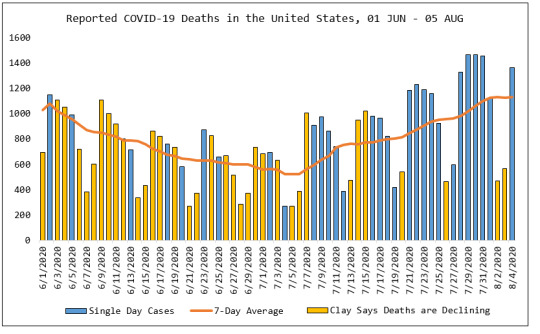
Clay is not stupid. He’s just actively dishonest for reasons that aren’t quite clear to me. As death counts came down from their grim April/May rates, Clay emphasized on a near-daily basis that deaths were (rightfully!) down. Right around this point in time cases were rapidly increasing across the country, so Clay continued to emphasize the low death totals knowing full well that they were a lag indicator.
When the deaths started to creep up, Clay refocused his attention to case counts which have started to plateau (which is good!). But he didn’t abandon his death argument entirely. He just merely spot picked days on a once or twice a week basis where death counts were low, generally emphasized on weekends or Mondays. This while knowing full well that any sort of moving average has death counts on a steep rise, comfortably double where this country was just a month ago.
And this is of course just country wide. He also gets going the state level, like this whopper on July 27th, or using the closures of testing centers from a natural disaster to signal boost low new case counts on August 3rd.
In summary: Clay Travis is lying to you. On the other hand, I’m sure the money is good.
0 notes
Text
Checking in on Bill Mitchell, The Godfather of Being Wrong
I thought the Krassenstein Twins era would be the low point of Twitter. Remember the shirtless cartoons? Remember all of the conspiracy theories? I suppose Seth Abramson is still chugging along. While the worst part of Democrat Twitter is hunting for the latest and greatest ten-pronged Donald Trump conspiracy theory, the worst part of Republican Twitter is doing what they do best, full and unadulterated gaslighting. No one does this better than takist Bill Mitchell. Bill prides himself on Being Right All Of The Time -- he’s a few months away from betting Diet Dews against Skip Bayless. Anyways, the best of the best gaslighters in this niche do two things well: they signal boost when they were right, and they bury where they were wrong. Burying comes in the form of either pretending they never said that (Mitchell is an exceptional tweet deleter), or moving the goal posts (he’s even better here). Mitchell has had a lot of takes on the coronavirus outbreak. Like many of us, he has zero subject matter expertise. That didn’t stop him from screaming to a rabid, half-million follower base about the danger coronavirus didn’t present to the American public. Of course, as the obvious severity of the issue has become more and more obvious, Mitchell just changed his tune -- April has seen him spending his days begging for an economy open-up, pretending death counts are fake, and calling out people like Anthony Fauci as Deep Staters. It should be noted that math isn't particularly Bill's strong suit.
Interesting that ActBlue raised an average donation of $30.38. This would imply people are donating in uneven numbers, including pennies, which would be odd. OR it would indicate untraceable foreign donations and an exchange rate translation, which would be illegal.
— Bill Mitchell (@mitchellvii) April 21, 2020
But it wasn’t always like this! One thing about Twitter is you can just .. kind of .. go back in time. January and February were reserved for occasional thoughts about the virus, China’s role, and the like -- mostly boilerplate stuff. In March, as limited cases spread into the States and concerns grew over the preparedness of the United States, Mitchell took it upon himself to carry as much water as he could for the federal government and their role in the pandemic. As time elapsed, Mitchell predictably transitioned his arguments and measurement criteria to whatever looked favorable for Donald Trump on a given day. Even a thirty day snapshot of this is comical. This is a daily collection of tweets from as far back as .... March of 2020.
Can you imagine the absolute PANIC if COVID-19 numbers were as bad an COMMON FLU numbers? https://t.co/hVzlwlbxWZ
— Bill Mitchell (@mitchellvii)
March 1, 2020
Imagine if we ever hit 60K dead here in the States. Imagine!
The USA is one of the most traveled to destinations on the planet. The fact we only have 88 confirmed COVID-19 cases and 2 deaths is a true credit to President Trump's efforts to keep us safe.
— Bill Mitchell (@mitchellvii)
March 2, 2020
Am I right in thinking the vast majority of US cases of COVID-19 were acquired outside the US mainland? So in essence, those really aren't US cases at all. They are international cases of people from the US.
— Bill Mitchell (@mitchellvii)
March 2, 2020
COVID-19 began by people eating infected snakes from a Wuhan market. Wuhan death rates highest by far. Is this due to lack of care or because ingesting the virus in food makes it more potent? Is China slowing down because people are no longer ingesting it just as with SARS?
— Bill Mitchell (@mitchellvii)
March 3, 2020
Imagine for a moment that COVID-19 targets only unborn children, killing a million American babies in the womb every year. The Democrats would be outraged, calling for Trump's impeachment for, "failing to protect the most vulnerable among us." We could rename it to ABORTION-19.
— Bill Mitchell (@mitchellvii)
March 4, 2020
As you know, abortions are ... contagious?
And so what if the mortality rate of COVID-19 appears higher in some places than the flu? You will NEVER get 31 million cases of COVID-19 in the US. You will NEVER get 34,000 deaths from this disease. And for the flu, 34,000 deaths is a SLOW season. https://t.co/eMDKepUd2V
— Bill Mitchell (@mitchellvii)
March 6, 2020
COVID-19 is serious and needs to be limited. But so is the flu - much much more serious. Closing down events, businesses etc. is overdoing it. The best solution. If you are sick, stay home. Don't go to see the Stones with the flu.
— Bill Mitchell (@mitchellvii)
March 6, 2020
As biological weapons go, COVID-19 is pretty mild. I mean, compare that to some of the NASTY stuff they came up with in WW1.
— Bill Mitchell (@mitchellvii)
March 6, 2020
COVID-19 isn't the flu. Until COVID-19 infects 31 million and kills 34,000 Americans, the flu is worse.
— Bill Mitchell (@mitchellvii)
March 6, 2020
Coronavirus "survivor" had a 3 hour fever of less than 100 and not a single symptom since there.
— Bill Mitchell (@mitchellvii)
March 7, 2020
So every time a new virus comes along that kills 3500 people worldwide we shut down modern civilization? COVID-19 seems to share a lot of common goals with climate change activism, doesn't it? Coincidence?
— Bill Mitchell (@mitchellvii)
March 8, 2020
How big a deal is COVID-19?
— Bill Mitchell (@mitchellvii)
March 8, 2020
(As an aside, this is one of any million of examples of Bill moving goal posts. First it was nothing, then it was real but not as bad as the flu, then it was like the flu. And so on. You may know this, but Bill Mitchell -- not a doctor.)
I am seeing more and more trollbot accounts calling themselves "Trump supporters" who aren't and are spreading COVID-19 #fearporn. This is a concerted effort by the left to over-hype this. It's obvious as yesterday they called for banning Trump rallies.
— Bill Mitchell (@mitchellvii)
March 9, 2020
There are a bunch of these but Bill’s surprise that this global health issue may not be political and, well, Republicans can actually be concerned with their health ...
Will companies start mass-layoffs for the COVID-19 dip? Unlikely. Hiring and training new staff is EXPENSIVE and CEO's understand this is all hype-driven. They don't want to unleash their hard-earned staff so their smarter competitors can scoop them up cheap.
— Bill Mitchell (@mitchellvii)
March 9, 2020
Certainly not an economist either.
How can Democrats say Trump is failing in his COVID-19 response when America is clearly outperforming the planet by leaps and bounds in prevention? More #FakeNews. https://t.co/VC1EO4J4nW
— Bill Mitchell (@mitchellvii)
March 9, 2020
The amount of hyper-hype surrounding COVID-19 is truly without precedent. Other than 15 people who died at an senior acute care facility in WA known for poor virus protections in the past, SEVEN Americans have died from COVID-19. SEVEN. Did you catch that? SEVEN.
— Bill Mitchell (@mitchellvii)
March 9, 2020
I've gotten a flu shot 3 times. 3 times I got the flu shortly thereafter. I won't be rushing to get a COVID-19 shot.
— Bill Mitchell (@mitchellvii)
March 9, 2020
Not a doctor.
I've gotten a flu shot 3 times. 3 times I got the flu shortly thereafter. I won't be rushing to get a COVID-19 shot.
— Bill Mitchell (@mitchellvii)
March 9, 2020
The media can bitch all they want about Trump's "failure of leadership" on COVID-19, but the bottom line is, in a nation of 350,000,000 souls, outside of one senior care center in WA, there have been just 8 deaths from this disease. That's REAL leadership and REAL results.
— Bill Mitchell (@mitchellvii)
March 10, 2020
What will be the next Democrat manufactured crisis after COVID-19 fades away with the warm weather?
— Bill Mitchell (@mitchellvii)
March 10, 2020
I keep hearing that deaths from COVID-19 are going to "explode" in the US any day now. WHEN?
— Bill Mitchell (@mitchellvii)
March 11, 2020
Not an epidemiologist, either.
A month from today, how many American will have died from COVID-19?
— Bill Mitchell (@mitchellvii)
March 11, 2020
This doesn’t have anything to do with Bill but boy is it depressing.
Just to be clear in case you missed it: 94% of all reported deaths from COVID-19 are in THREE countries. The largest of those 3 accounting for 70% of all deaths has slowed expansion to a crawl - they've beaten it. Take away these TOP THREE and you have only 291 global deaths.
— Bill Mitchell (@mitchellvii)
March 12, 2020
Ignore the dead people and you have less dead people. An update to this one would be nice.
Looks like the COVID-19 updates are in: USA - 1 new death. 10 in serious condition. Hardly the zombie apocalypse we've been promised.
— Bill Mitchell (@mitchellvii)
March 12, 2020
Other than Japan, the USA is clearly doing much better than any other major nation - and yet, the #Media is calling Trump's efforts an abject failure. Remove the 26 deaths from one nursing home and there have been only 15 deaths in America attributed to COVID-19. pic.twitter.com/nM2iZtGy3c
— Bill Mitchell (@mitchellvii)
March 13, 2020
What do fake climate models, fake COVID-19 models and fake polls have in common? They are all fictional numbers created for one purpose, to provide a premise for that days #TDS news cycle. None of it is real.
— Bill Mitchell (@mitchellvii)
March 13, 2020
March 13th is one of the earliest days where Bill began positioning his next line of arguments, transitioning from “the numbers don’t exist” to “the numbers do exist but now they aren’t real”.
I'm amused by people who say, "just the flu." The flu infects millions and kills 10's of thousands. When COVID-19 gets to that level, ring a bell so we'll know. https://t.co/ZUD9F54NZr
— Bill Mitchell (@mitchellvii)
March 14, 2020
US testing for COVID-19 is really taking off. Expect infection numbers to spike and mortality to plummet. I'm guessing we'll be under 1% US mortality within 2 weeks and under .5% in a month.
— Bill Mitchell (@mitchellvii)
March 18, 2020
Not a mathematician. Certainly not a freaking mathematician.
What makes the 127 lives lost to COVID-19 so much more valuable than the 50,000 lives lost to the flu?
— Bill Mitchell (@mitchellvii)
March 18, 2020
Six weeks and annualized and .. yeah.
100% cure rate + warm weather = the end of the COVID-19 panic. Of course, the #Media won't want to let this go since it'a all they've got, but just a matter of time now. https://t.co/V0eIsydR4H
— Bill Mitchell (@mitchellvii)
March 20, 2020
Mitchell has frequently criticized the media, an easy target with such significant failings on both sides of the political aisle. But he also will very quickly circulate anything that coincides with his unfounded, baseless, void-of-science beliefs. From those same media outlets. Every time. “Believe it only when I say so.” The usual.
No one cares about flu deaths because the flu is "common" and has no fear factor. It cannot be used politically. And yes folks, this is ALL about politics. This is all about beating Trump. It won't work. Tell me when COVID-19 reaches 55,000 US deaths.
— Bill Mitchell (@mitchellvii)
March 20, 2020
Yes, tell Bill when we reach 55K deaths here in the States.
Dr #FearPorn Fauci is the designated Democrat Debbie Downer of the #COVID19 crisis: Vaccines are beginning trials! FAUCI: "Those will take years of testing."#Hydrochloroquine very effective treating COVID-19! FAUCI: "We need massive, slow testing before that is used." Jerk.
— Bill Mitchell (@mitchellvii)
March 20, 2020
Bill Mitchell, not a doctor.
Here's the deal. If you are on Trump's COVID-19 Task Force, you DO NOT run to CNN and CONTRADICT the President unless, YOU ARE THE ENEMY. FULL STOP. https://t.co/72UdoU0p9I
— Bill Mitchell (@mitchellvii)
March 20, 2020
See prior.
COVID-19 will be over as a serious global threat within 60 days, and perhaps sooner.
— Bill Mitchell (@mitchellvii)
March 22, 2020
All of the arrogant liberals telling us COVID-19 is the worst disease ever to strike mankind will crawl back under their rocks in another 30-60 days when this is all over - then come back out next time some new fake disaster arises to harm Trump.
— Bill Mitchell (@mitchellvii)
March 22, 2020
Studies have shown, as with H1N1, CFR'S tend to be inflated by a factor of 10 early as only the sickest are tested. As time passes this changes and CFR plummets by a factor of 10. In the end, COVID-19 will be no more deadly than H1Ñ1 which was no more deadly than THE FLU.
— Bill Mitchell (@mitchellvii)
March 23, 2020
“H1N1 caused 18,500 laboratory-confirmed deaths with an estimated 151,700 to 575,400 deaths total in two years.”
Trust me, within 60 days, the #Media will be writing articles that COVID-19 was, "a scam by Trump all along." "He always knew there was a cure but withheld it for maximum effect." They'll even find some way to tie it to Russia. You KNOW it's coming.
— Bill Mitchell (@mitchellvii)
March 23, 2020
NY is clearly the COVID-19 apex in America. Word is major #hydrochloroquine testing may begin there tomorrow. If that happens and shows results, it's just a matter of time before President Trump has defeated "a once in 100 years" outbreak, as the #Media loved to call it.
— Bill Mitchell (@mitchellvii)
March 23, 2020
By wildly overhyping COVID-19, Democrats have set Trump up to be the GOAT when this thing ends in the next 30 to 60 days. They put the ball on the T for Babe Ruth with the bases loaded.
— Bill Mitchell (@mitchellvii)
March 24, 2020
So far today, new COVID-19 are lagging yesterday's numbers. Of course that can still change, but we are NOT seeing exponential growth. This looks like the top of a bell curve. pic.twitter.com/Fj99H9q2kA
— Bill Mitchell (@mitchellvii)
March 24, 2020
Not a mathematician.
My sixth sense is telling me that the research done on creating a COVID-19 vaccine will lead to a completely new approach to fighting viruses and a "Universal Virus Vaccine" which defeats all viruses ability to attach to and invade human cells.
— Bill Mitchell (@mitchellvii)
March 25, 2020
By the 25th of March, we were in Bruce Willis territory.
History will look at COVID-19 as the greatest overreaction in medical history based upon politics.
— Bill Mitchell (@mitchellvii)
March 26, 2020
There were about 15K dead globally at the time of this tweet. We are now at a quarter million dead, one month later.
Since the COVID-19 outbreak began, Diarrhea has killed 900,000 people. Can someone link me to the best Diarrhea Tracker? I'd like to avoid dying from Diarrhea. Thanks.
— Bill Mitchell (@mitchellvii)
March 26, 2020
I don’t even know, I had to include it though.
If COVID-19 numbers doubled the seasonal flu, I'd be concerned. https://t.co/pZYZOgXPLh
— Bill Mitchell (@mitchellvii)
March 27, 2020
A great goalpost move. A week prior it had to “match” the flu. Now it’s double. Then we can talk!
I would not put it past Cuomo to alter New York's mortality numbers. Are they counting deaths WITH or FROM COVID-19? Something strange is going on there.
— Bill Mitchell (@mitchellvii)
March 29, 2020
Around the end of March, coinciding with the inevitable exponential growth being experienced in the States, Mitchell strengthened the transition from ‘not a problem’ to ‘not really a problem’ to ‘it’s not worth shutting the economy over’ to 'the numbers are fake’. Which is odd, because as far as I can tell, Mitchell has never disputed -- in the literal sense -- the existence of coronavirus.
I am seeing hundreds of tweets from people who had a "weird flu" in December. Many of the COVID-19 symptoms, but tested negative for flu. No one described this as "life-threatening," just the flu, maybe a bit on the mild side.
— Bill Mitchell (@mitchellvii)
March 29, 2020
Not a doctor.
I take whatever mortalities I see reported in Italy and divide by 10 to get close to those actually killed by COVID-19. Their counting method is preposterous. 11% CFR is BS.
— Bill Mitchell (@mitchellvii)
March 29, 2020
GOOD OLD DOCTOR DOOM IS AT IT AGAIN ON CNN, HIS FAVORITE SPOT TO DUMP ON TRUMP - Fauci: U.S. Could Have 100k to 200k Deaths from Coronavirus https://t.co/oB7nXarQo1 via @BreitbartNews
— Bill Mitchell (@mitchellvii)
March 29, 2020
The States are over 60K dead as of today, so "Dr. Doom” appears to be forecasting with a reasonable degree of accuracy, unlike Bill, who is not qualified for any of this.
If 80,000 die from COVID-19 it would be roughly equivalent to a bad flu season we'd normally ignore.
— Bill Mitchell (@mitchellvii)
March 29, 2020
(Goal posts. Now it’s 80,000.)
Seems as if the exponential growth in COVID-19 deaths is always, "The Day After Tomorrow." I was assured two weeks ago we'd already be at many thousands of US deaths daily by now.
— Bill Mitchell (@mitchellvii)
March 30, 2020
It seems Dr Birx and Dr. Fauci are completely discounting the effects of warm weather and #hydrochloroquine on COVID-19.
— Bill Mitchell (@mitchellvii)
March 30, 2020
In summary: Bill Mitchell is a dangerous fool. And that is apolitical.
0 notes
Text
The Honda Experience
A friendly word of advice for anyone in the market for a new car: if you see a Honda dealership, head in the opposite direction.
I’ve been intermittently tweeting about “The Honda Experience”, mostly because it has been so comical that if I didn’t tweet through it I would have spontaneously combusted. But I figure I’m doing a disservice half-joking about it to a bunch of people who may seriously be looking to buy a Honda.
My Honda has no more than 2K miles on it currently. Last week, I tried to fire the engine up and, boom, car is completely dead. Strange. I put the jump box on the car. Nothing. I jump it off of another car. Nothing. On a last ditch effort (and under the assumption that it may have needed more from the donor vehicle) I jump it off of a massive truck, and that fired the car back up.
The car, again, has 2K miles on it. No more. And after getting the vehicle to start, I start looking around for anything owner induced. Nothing. So I start researching “2019 Honda Battery Dead”, or something to that effect, and voila: a massive chorus of people complaining about high rates of infant mortalities. In fact, there was a service bulletin furnished by Honda on March 29, 2019 addressing this very issue. In pertinent part:
After the vehicle is parked for an extended period, the PCM begins an evaporative system leak check after meeting certain criteria. Under certain conditions, it may not return to sleep mode, causing the battery to discharge
I wasn’t fully sure if the dead battery was induced or if the above service bulletin was at play. I did find it odd that the only way I found out about a service bulletin against my vehicle was through Googling and not, you know, a formal notice. [I could get into the very obvious issue of Honda selling me a car with a known grounding issue, but I’ll just note that one for now.] But I still wasn’t entirely sure what the root cause was.
Only way to find out was, well, see if it happened again. It sure did! Twice, in fact, over the next six days. On the third and final attempt, nothing would jump the car. Which I figured was probably for the best: let Honda tow it in to the dealership, let the dealership fix the issue(s) and any applicable recalls, and put the matter to rest.
Funny, that. Honda Roadside told me a tow would be contacted in a few minutes and the truck would arrive within the hour. Reasonable, especially considering they are trying to liaison with third parties.
I thought that until the six hour mark. I swear, if I had a shovel I would have started digging a shallow grave. When I called back Honda Roadside I asked what the hell had happened. The service operator was pleasant and put me on hold to figure out what occurred. The hold was a half hour long, which was also comical. When he returned to the call, he blamed a delay with AAA and told me a truck would be at my car … in an hour. The one thing that’s really hard to articulate here is the absolute mass confusion on the Honda side. It was awfully obvious that there had been a major disconnect somewhere in the process, and of course, the next notification I would get regarding ANY delay or ANY logistical issue would be the first. (Still waiting, in fact.)
At around the three hour mark of waiting for the tow truck, I get a ride to the subject dealership to arrange for a loaner vehicle. Since both myself and Honda were convinced this was a manufacturing defect, I didn’t expect any sort of issue. Incredibly, while arriving at the dealership, I was told that if Honda didn’t tow my car quick enough (!), they wouldn’t have time to arrange a loaner vehicle.
As my eyes rolled aggressively into the back of my head, the services manager pivoted and then mentioned that, believe it or not, others could help me if the timing didn’t work out. So I headed over to Enterprise -- who was fantastic, by the way -- and a rental was quickly setup. On my card. But at least I could drive.
That morning, the Honda dealership calls me to let me know they are working the service bulletin issue and a separate, unrelated recall. Cool. Eight hours later (and amazingly, mere minutes before the shop closes for the weekend), I get a call that the car is fixed and ready for pick up. Major nuisance on the weekend, but at least my car was back and the dealership, unlike Honda Roadside, took initiative to mitigate a problem they induced. (Same dealership that sold me the car, mind you.)
Wrong. Wrong. Mystifying. The car rolls up, so I know the battery issue is resolved. I jump into the car and am notified that a couple of fuses had blown, one heading into the radio and dashboard, and that it had been replaced. How were those fuses blown? Utterly no idea. Perhaps induced at the shop, perhaps induced prior. Again, didn’t mind -- the car was at least back to full health.
Until I jumped in the vehicle. You know, Maintenance 101 is something to the effect of (a) isolate the fault; (b) effect troubleshooting and begin replacing suspected component(s); (c) continuously ops check to ensure that issues have been resolved. When I jumped in the vehicle, the dashboards were frozen and the satellite system was inoperative. A bunch of services guys huddled around the car and asked me (!) if I wanted to take it and bring it back Monday. Here I am knowing full well they didn’t ops check anything with the vehicle, and probably a coin flip chance at best of them having truly fixed the battery issue as well.
2K miles on the car. It has been quite the ride. That’s a figurative ride, mind you. The literal ride I’m still waiting on.
To recap:
1. Known defect on a brand new car; 2. No notification of defect on brand new car; 3. Three completely inop vehicles in one week; 4. A six hour (!) tow, with no notification or dialogue. The tow only arrived after I pressed the issue; 5. A dealership, or at least some individuals within the dealership, that didn’t particularly care for the inconvenience induced by Honda; 6. A dealership, or at least some individuals within the dealership, who do not understand basic maintenance and troubleshooting principles; and 7. From start to finish, the worst customer experience of my lifetime.
Other than that, Honda’s doing great.
0 notes
Text
Six Past Jones
I'm not sure I have seen a more polarizing team than the 2018-19 San Jose Sharks. They can pierce the interior of any defense in the league, they are completely careless and indecisive in their own zone, and they play in front of a sub-replacement level goaltender who was out-played by Cam Ward this season. Cam Ward!
The problem is that you can't fix the goaltending. Not this year, anyway. You can argue until you are blue in the face about what the front office could and maybe should have done last summer or at the trade deadline, but that does nothing for the 2018-19 playoffs. What makes matters worse is that Aaron Dell may be one of the three goalies in the league less capable at stopping shots than Jones. It's hard to believe.
That said, I'm fascinated by how much blame is being levied on Jones this first-round. I think it's clear I don't have any interest in defending Jones -- he's struggled all year and a good goaltender finds ways to stop difficult shots.
Emphasis on difficult shots. That's all San Jose appears to give up. I know that Vegas is a ridiculously good team and that the talent in this series is probably second to none, but I went back and re-watched every shot taken on Jones last night and boy were a good portion of them legitimate scoring opportunities.
For the sake of whatever this is (a blog? a post? a thread? a thing?), I'll limit it to just the goals. But it's fascinating how many concrete breakdowns occurred before the shooter was even teed up.
Let's go goal by goal. The highlight package is here if you want a quick video reference on each:
youtube
VGK goal one: Pavelski, Couture, Meier, Dillon, Karlsson
How it happened: a simple neutral zone transition play. Couture gambled and missed, and Dillon and Karlsson were spread east/west with no recovery option.
This is a breakaway goal ten seconds into the game with no counterattack opportunity. This is a laughable loss of defensive assignments and most of the lapse falls on the shoulders of Couture. Stone went right around Couture (who tried, weakly, to poke check the puck away). The nearest defender in Dillon just doesn't have the type of foot speed to close that gap, and the other defender in Karlsson was isolated on Stastny.
This is a total defensive collapse. I'm not sure how much you can hang on Jones here. Yes, he could have stopped the puck. But this is the type of shot that carries a huge expected goal value because (a) it's from in-tight; (b) it's unobstructed; (c) the shooter is an elite one; and (d) the goaltender is objectively bad. Enough said.
VGK goal two: Couture, Hertl, Braun, Karlsson
How it happened: Evander Kane takes a bad double minor penalty, San Jose loses the subsequent offensive zone draw, Jones can't stop the shot through screeners.
I once joked that the vintage Evander Kane game is a highlight reel goal, an unbelievable assist, some physical play, and at least two terrible minor penalties. Anyways Kane's double minor put San Jose over the barrel right out of the gate and Hertl immediately loses the draw. Pacioretty is in a decent shooting spot just on top of the circle, but he does have a beautiful screen from Stastny. Pacioretty had so much time that Braun had to step up to challenge the shooter, which left Stastny by himself on the screen. This is a shot you would like to see Jones fight through and make a save on, but it's not an easy stop either.
VGK goal three: Pavelski, Couture, Meier, Karlsson, Dillon
How it happened: Defensive zone breakdown, again. San Jose wins a brief board battle but Timo Meier can't clear the zone, thanks largely to a great play by Mark Stone. Also: San Jose was unintentionally a man down.
Meier made the cardinal sin here of not only committing a bad defensive zone turnover, but doing so with Vegas' most deadly scoring line out there. At the time of the pass Meier really only had one option -- a relatively wide open Karlsson ten feet in front of Jones. I think Meier wanted to make a more conservative play than putting the puck in the middle of the ice, but there was no option available. He tried to flip the puck in the air and, lo and behold, Stone snagged that from the sky and immediately put San Jose in a bind. From there the Sharks are in complete recovery mode, though they're also a man down. Logan Couture is halfway in the neutral zone when this turnover occurs, and Vegas has a huge numbers advantage. Stastny scored on a great shot through a sea of bodies.
VGK goal four: Hertl, Couture, Braun, Burns
How it happened: Joe Thornton takes a two-minute minor for an illegal check to the head (it probably should have been a game), and Vegas runs the sequential passing game in the OZ. Logan Couture took another gamble and lost.
Marc-Andre Fleury had made an unbelievable save on Evander Kane just moments earlier for this goal. The next shift, Vegas beautifully gains the OZ and runs a tic-tac-toe passing sequence between Shea Theodore, Mark Stone, and Paul Stastny. What opened this play up was Couture losing his side of the ice, allowing for a clean OZ entry. Couture scrambled to try and attack the puck carrier but was already a step late on him. Then, seeing the passing sequence being set up, tried to recover again and backcheck on Stastny. Stone did thread a beautiful pass here through a tight window but if Couture doesn't gamble initially, he knocks this puck clean away.
Jones could not have stopped this shot.
VGK goal five: Hertl, Pavelski, Kane, Burns, Karlsson
This one is painful to watch. San Jose has the puck clean in their DZ. Burns makes a bit of a miscue of a touch, and then compounds the issue by trying to make a conservative 'chip out' play away from Stastny. Stastny took the puck right off of the boards and immediately started the counter. Kane, in recovery mode, was a half step behind the trailing Stone. Stone receives the puck and dumps it off to Marchessault who is wide open. In this one-second window, Kane somehow completely lost Stone or tried to pass him off to one of the defenders (that seems unlikely, but whatever). Also confusing is the fact that Kane started trying to take away Marchessault's angle despite Karlsson being closer in proximity to defend that shot. Marchessault's shot is a rebound deposited right in front, and Stone -- who had somehow shaken every Sharks skater, including (but certainly not limited to!) Kane -- finished up the sequence.
Jones owns some poor rebound control here but this is another collapse. Burns makes a bad play, then Kane, then Jones. This one sucked across the board.
VGK goal six: Thornton, Labanc, Sorensen, Dillon, Karlsson
How it happened: San Jose, chasing the game at this point, tries a give-and-go play through the neutral. Dillon can't close the counter quick enough, and somehow a 3-on-3 rush is turned into a 2-on-1.
San Jose deserves a little more leeway here because they are trying to erase the deficit late but the give-and-go sequence failed and jump-started a Vegas counter. What kills San Jose here is that Dillon, in recovery and sandwiched between both Stastny and Stone, can't get to either of the two. He tries to attack the puck carrier (and fails). Stastny feeds a beautiful pass to a streaking Stone, and a gassed Sorensen doesn't have the energy or the foot speed to catch him. That puts Stone and a trailing Pacioretty in tight on Jones, with Karlsson trying to take away the pass.
Jones completely loses his net on this one. In my opinion it's the worst goal he gave up on the night, if only because he lost his position and took away the wrong of the two angles. I suspect better goalies have a much better chance at stopping this shot, but we are still talking about weighted coin flips in a classic two-on-one scenario with a shooter in the crease.
All this to say: Jones is killing San Jose. What's also killing San Jose is San Jose. I'm not sure I've ever seen a team with this much skill this blissfully unaware of defensive assignments or this disinterested in defending. Defenders are constantly being beat to positions, backchecking forwards keep losing their assignments and taking needless gambles, and there's just no eraser between the pipes to afford any of that.
This is a tremendously talented San Jose team that can out-score anyone. But you defend like this, there is just no chance of winning a Stanley Cup. And just going through the six goals against, there are an awful lot of negative contributors here.
0 notes
Text
A Strange Twitter Account
Update: The user described himself to me as a fan and resident of the city who uses Twitter to “disagree with the echo chamber”. He did not want to share additional information.
____________________________________________________
A few weeks ago a hockey media friend made note of an odd Twitter account that had emerged in December of 2017. The account was created to yell at a fan for not understanding how an AHL paper transaction worked. The team had assigned a few players back to the Belleville Senators (edIt: incorrectly put Binghamton here previously), Ottawa’s AHL affiliate for the Christmas break. (The plan was to re-assign them back to Ottawa once the break concluded.)
The person wasn’t tweeting to his followers, though. He had simply replied to a tweet from Ottawa’s media/comms account, which is really only utilized for official team releases. The people who follow it tend to be media people, die hard fans, and the like. Anyways, the person was wrong, and so this account decided to correct them.

Now, anyone who spends five minutes looking at the Twitter profile here can realize this is a second account, which is surprisingly common on Twitter. The person auto-followed a bunch of super-celebrity accounts when the account was first created, and has since then only followed (a) people from Barstool Sports, which I can’t reconcile at all; and (b) people in and around the Ottawa Senators organization. But the person doesn’t interact with anyone that he follows. Nor does the person tweet to his followers, perhaps because they don’t exist. Six months, zero tweets.
But 276 tweets total, all of which consist of moving into conversations taking place between people in the Ottawa hockey community. It’s a curious pattern because many of these conversations are being had between people who really don’t have a lot of followers, and share no commonality other than being hardcore Ottawa fans who have opinions on, well, everything. The account was clearly designed to shadow conversations between these people, though the account doesn’t actually follow any of them.
Whoever it is, the person is pretty entrenched within the Ottawa hockey community. And they know an awful lot about the team. Ottawa has a sizable fan base but I think it’s fair to say that the size of their fan base that actively reads, reviews, and reacts to the most mundane stories within the organization and it’s AHL affiliate is pretty small. I have no idea who is behind the account, but the number of people who could be is probably considerably smaller than what we think.
Anyways, let’s talk about the material on the account. The tweets follow a common theme:
1. They only tweet about the Ottawa Senators and their AHL affiliate 2. They are particularly supportive of the decision makers in the organization
The second point branches off into a bunch of sub-points. The person is extremely supportive of the team’s general manager as one example. Here is what he or she has to say there:

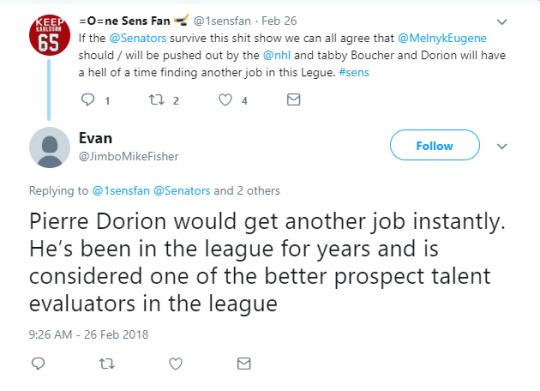

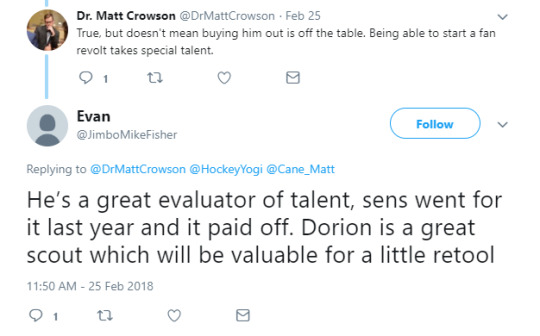


Anyways, you get the point. It goes on and on and on. I can’t possibly compile even half of the material related to the front office -- about half of the tweets published are dedicated to their work.
The second most common theme? Staunch defense of decisions made by the Ottawa Senators over the past few years. Some of the arguments go back as far as 2011, like when the person became aggrieved at a discussion over Mark Scheifele, Sean Couturier, and Mika Zibanejad:

To be sure, he’s not a big Zibanejad fan. He made this clear a few times on his page:
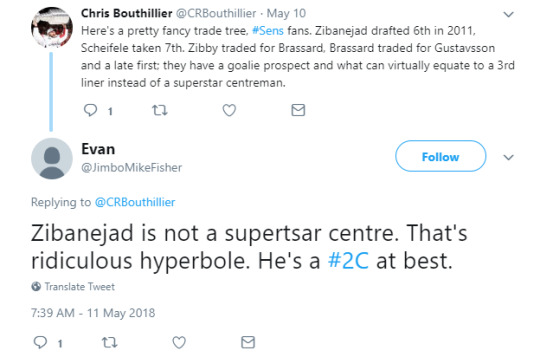
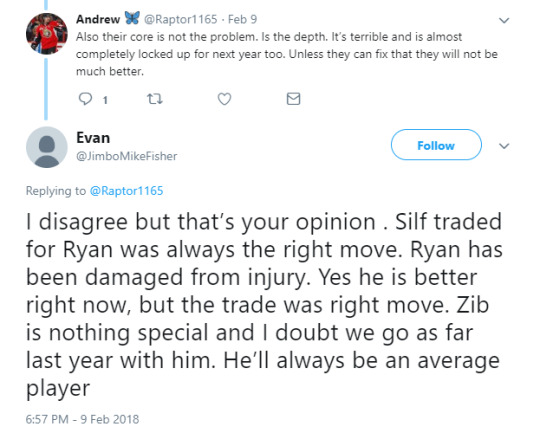
He also liked the trade for Alex Burrows. The one that shipped prospect Jonathan Dahlen over to Vancouver last season:

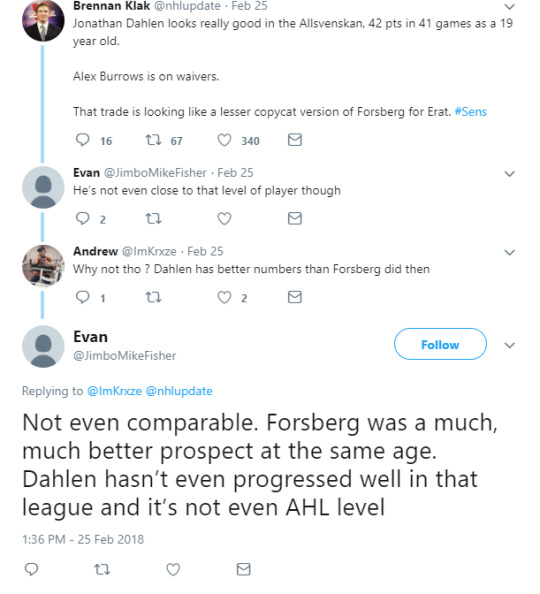
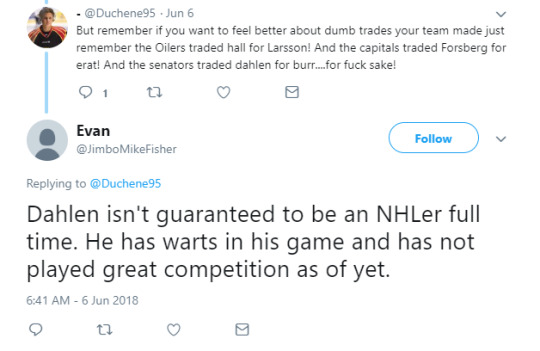
Then there was this one-off defense of winger Magnus Paajarvi tweeted back in March. There, he believed the player should be awarded an extension.

..and Nick Shore, who was acquired in the larger Dion Phaneuf trade and then re-packaged over to Calgary. Yes, Nick Shore. Here’s a sampling:

The person shares an awful lot of thoughts about Erik Karlsson. There are way too many of the tweets to capture, but the theme is: (a) He was the primary reason they were bad last year; (b) The team can offer him a ton of money or money is not an issue; (c) The team wants to sign him, but the onus of the extension is actually on the player. It started here, which was actually the first tweet he published after that random complaint about the AHL paper transaction.
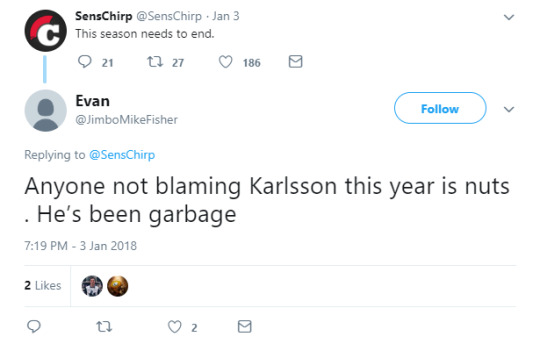
..and has since evolved.


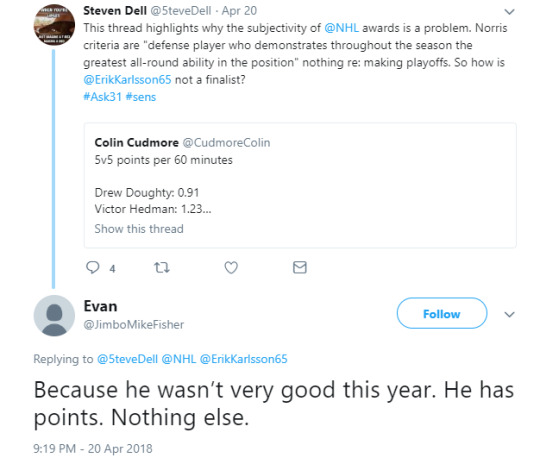
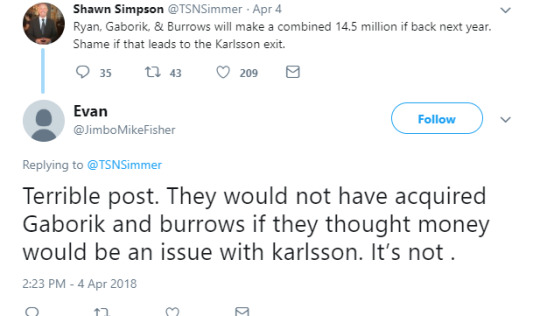
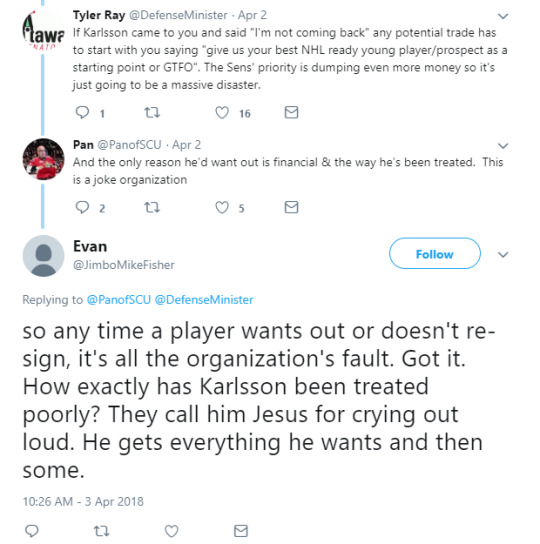

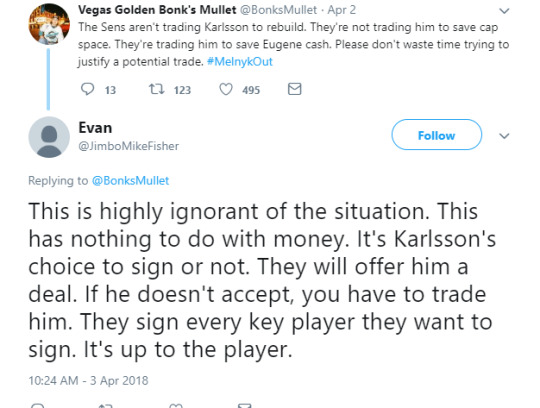
Months ago, he knew Karlsson was interested in signing. First hand, whatever that may mean:

Wonder if that has changed since.
Then there’s Mike Hoffman. The person doesn’t love Mike Hoffman’s game and believes him to be a complementary player. This started back on January 11th, when he said that any Hoffman trade made would have nothing to do with salary/money.

Speaking of money -- the person pointed out to a fan tweeting into an abyss of 96 followers that he was wrong about the point he was making about Clarke MacArthur’s contract being an issue, because that contract was insured. (He is correct, again.)
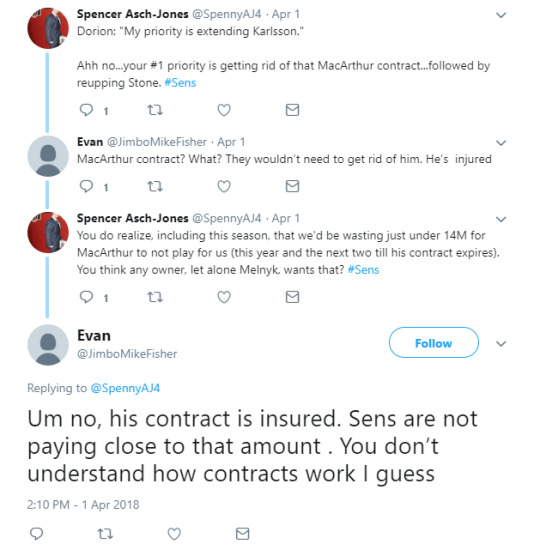
Much like the departed Zibanejad, the person’s not a fan of Kyle Turris either:

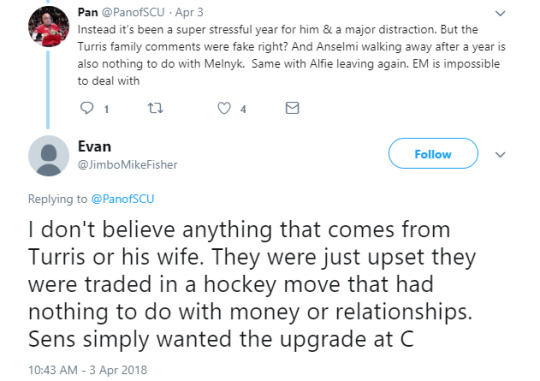
And if the person is a fan of the team, he sure as hell doesn’t seem to like the rest of the fan base.

Lastly, they love Brady Tkachuk. I mean love the guy. (He is good!)

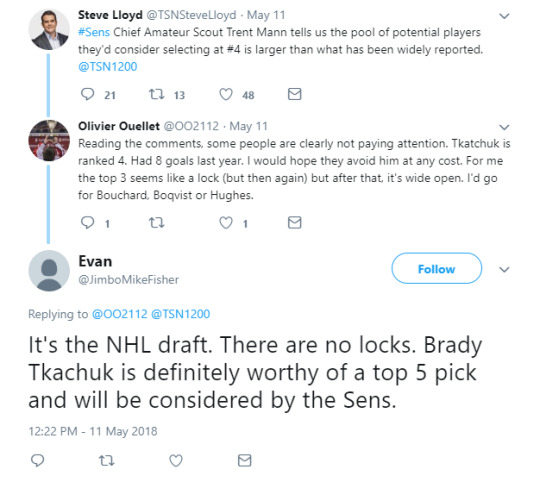
Anyways, not sure I have ever seen anything like this before. Someone created an alternate account to defend Ottawa’s honor at all costs. And they sure as hell seem to know what they are talking about -- you may or may not agree with his opinions, but the statements of fact all check out -- from MacArthur’s insured contract to Belleville organizational structure and so on. Whoever it is, you have to admire the consistency and dedication. I truly have no idea who it could be.
If it’s a fan, I’ll be damned if they aren’t the biggest Ottawa Senators fan on the planet, though I hope they argue with me and everyone else on their real account at some point down the road.
If it’s not a fan, then I’m even more confused.
48 notes
·
View notes
Text
Sayonara Sixty Five
Two months ago I put together a series of thoughts on the state of the Ottawa Senators and the organization’s financial distress. Point number two was dedicated to Erik Karlsson.
I encourage you to read the entire linked post, but I’ll quickly paraphrase each subsection. a) We were seeing only the beginning of Erik Karlsson vs. the Ottawa Senators; b) The justification underpinning the ‘Erik Karlsson had to submit a no-trade list’ was junk based on the timeline provided; and c) The primary driver behind the strained relationship was specific to ownership, and not the front office.
The trade discussion encircling Karlsson and Ottawa is now inescapable. Ask ten people about the feasibility about a trade and you’ll surely get ten different responses. The one thing I wanted to do though is spend some time talking about the things I have heard over the past half-season and, more generally, providing an eleventh thought – based on what I know – about a potential trade.
So, let’s begin.
1a.) All of the organizational in-fighting really comes down to two people: the owner, and the player. There are three things professional athletes want – long-term security, a lot of money, and a chance to win championships. Ottawa has always had the upper hand on the first point. Karlsson clearly loves living in the city. That means quite a bit. Historically, be it the NHL or any other major league, it becomes increasingly difficult to pry a player out of his ‘home base’ as he develops more and more comfort with his environment. It’s no different than any employee of any organization, really.
But the other two areas are huge going concerns. Not to beat the deadest of dead horses into the ground but Ottawa’s financial situation is grim. The team wasn’t financially stable when they were winning a ton last year. One can only wonder what it looks like now, with continually sliding attendance and a team that couldn’t string together a series of wins at any point during the season. The team has few remaining executives. Some have ‘left’ the company. Some have been fired. Some have been fired and turned around to sue the team. The owner is now juggling multiple executive hats. It’s created incredible uncertainty within the organization, and that’s permeated into the locker room.
Can this team – a team in a full-blown rebuild with a [still recovering?] superstar player looking for a max contract – genuinely afford an $80mm contract, a contract which will likely carry heaps of signing bonus money and some front-loading? It just seems increasingly unlikely. And if the team is dedicated to a true rebuild plan as reported, does the Karlsson retention even make hockey sense? It’s a valid question.
1b.) I cannot emphasize this point enough, and I’m sure I have written it a half-dozen times or so now: do not discount the impact that Daniel Alfredsson leaving the organization had. Or the impact it had when he left the organization for a second time. Or the discussion surrounding Kyle Turris’ exit from the team. Or any of the unhinged rants about financial investment into hockey operations. It’s created two perceptions, fair or not. The first is that the team is selectively loyal. (As an aside, I think all teams and all players should be selectively loyal. But these are the issues you can run into when two or more parties aren’t aligned.) The second is that the team is not serious about winning a championship, or has no plan to win a championship, or both.
1c.) General managers can pick up a phone and call Pierre Dorion and talk about a trade. Players can pick up a phone and call Erik Karlsson and talk about what it’s like to play for an organization. The latter is true regardless of whether a trade materializes today or if he leaves the organization when his contract expires. This is, to be absolutely clear, happening.
2a.) The discussion around whether or not Erik Karlsson will be moved at the trade deadline is interesting, but ultimately immaterial. It’s true that increasing the market is probably in Ottawa’s best interest and that would mean a summer trade where teams aren’t already hitting their heads on the cap ceiling. But there’s also an incentive for true contenders to make a swing at Karlsson right now. As one example, it’s almost certainly in Tampa Bay’s interest to make a deal today. They’ll get two shots at a Stanley Cup with Karlsson on a super team-friendly contract versus one. And they have enough cap room to make a trade work, though reports about Ottawa’s desire to include Bobby Ryan’s contract into this deal make it awfully difficult.
2b.) If you needed any further indication that this move is about clearing money above all else, the Bobby Ryan attachment would help solidify it. Karlsson, on his deal and in his condition, is one of the most valuable trade pieces a team can possibly have. Even entertaining the idea of utilizing his value to get off of yet another bad contract should tell you all you need to know. And, again, a Ryan inclusion makes this deal infinitely more difficult from a trade deadline perspective. A team taking on roughly $14mm in cap just doesn’t happen in March – not unless it’s a mega-trade of truly epic proportions.
3.) The organization can’t technically negotiate with players until a certain interval pre-dating their contract extension is reached, but that doesn’t stop groups from having, uh, informal discussions. It’s one of the big reasons why you see a slew of contract extensions on the same day in the summer (the NBA, which has a similar CBA in this light, has a ridiculous rash every single summer). Teams and players generally know the landing spot for a deal and when they are able to execute on it, they sign the dotted line and move on. Not that Ottawa needed any reinforcement but it seems reasonably likely to me that they are aware that Karlsson’s not stepping down on his contract demands any time soon. As I noted earlier, even if he’s paid marginal top-out on an 8-year deal, that’s at least $80MM in liabilities to a single player. This is the part that I think Karlsson, right or wrong, will have to wear. His commentary about wanting to be paid top dollar has had a chilling effect on negotiations before they could even begin. And it’s one of the reasons behind Ottawa “aggressively listening” to Karlsson trade proposals.
4a.) I don’t think Erik Karlsson wants out of Ottawa. I do think he wants out of the Ottawa Senators organization. He is, to quote multiple sources close to the situation, “unhappy”.
4b.) There are two ways Ottawa can retain Erik Karlsson. The first is an ownership change. (One including Daniel Alfredsson would surely be a plus.) The second is rebuilding a bridge that’s been so thoroughly burned you can see the smoke from Sweden. I’m skeptical that this can occur but if Pierre Dorion is genuine about his desire to retain Karlsson, he needs to first play the role of middleman or mediator, then convince his cornerstone player that the team has a real plan in place to succeed long-term … then give him at least $80mm.
5.) My opinion, and my opinion only: I just don’t see how Erik Karlsson is in an Ottawa Senators sweater come October 1. Maybe it’s a deadline deal. Maybe it’s a summer deal. But I’m reasonably convinced we have reached a point of no return and although a lot of people will point to a disappointing 2017-18 season as the genesis, the reality is the relationship has soured over years of increasing distrust and skepticism on trust and organizational direction.
4 notes
·
View notes
Text
Powder Keg
Here are a few fun facts about Ottawa Senators forward Mike Hoffman:
1. His 91-goals over the last four seasons are 22nd best in the NHL; on a rate-basis, that’s identical to Joe Pavelski and Filip Forsberg 2. He is on pace for his 4th consecutive 20+ goal season 3. He carries a $5.1mm AAV cap hit through 2019-20 4. Ottawa is +39 in goals with him on the ice;
At this point in his career, it’s reasonable to conclude that Hoffman is a first-line forward on a team-friendly contract in the prime of his career. It is also reasonable to conclude that he’s one of the league’s preeminent goal-scorers and whatever defensive deficiencies he may (or may not) have are sort of moot because, well, Ottawa always out-scores the opposition when he’s on the ice.
Hoffman is the type of player every team around the league covets. Every single organization -- from Stanley Cup contenders to tank-heavy rebuild teams -- are in the market for an impact player, and these guys just don’t shake loose very frequently.
That appears to matter little to Ottawa, a team now militantly hunting for any and every way to shed player salaries. I know this because the owner last week proclaimed that he would cut player payroll next because he had already cut non-roster personnel to the bone.
Hoffman trade rumors have been making the rounds for the last few days and you already get the sense that this team is going to pitch this type of trade as a way to spark the rebuild and improve the team long-term. After all, Hoffman is a desirable asset to most teams (all teams?) and is the type of player that can provide future assets that Ottawa sorely needs. So the argument will be shoehorned as pain now, gain later.
It is here you might ask why Hoffman doesn’t fit into the picture through this rebuild. Hoffman, by most first-line standards, is underpaid. And since he still has 2.5 years left on a contract that only carries him through the age of 30, there’s stunningly little long-term risk in keeping him around. Ottawa’s clearly better with him on the roster today and is almost certainly going to be more valuable than whatever asset(s) they get in a trade. I know this because, uh, only 20 or so players have out-produced Hoffman over the last four years, and the vast majority of those names are franchise cornerstones who border on untouchable.
Well, it’s worth reiterating what we know about the Ottawa Senators. They are cash poor and prioritize spending less money than their competitors above all else. Paralyzed by a grim financial outlook, Ottawa will continue to look for any way at keeping costs down.
The last six years or so has been a stark reminder on how serious they are about winning. They have spent $73mm less than Philadelphia over that interval, which is one fully-burdened roster these days. They have been out-spent by a sun belt team in Nashville. They have been out-spent by New Jersey, who were carrying at least $230mm of debt in 2013. They have been out-spent by Buffalo, who have actively purged personnel *at least* twice in an attempt to tank for draft picks. Their closest comparable? Florida -- a non-competitive team that reportedly was in the hole to the tune of $154mm in 2015. (That sounds familiar!)
So, Ottawa’s in a bind now -- the organization is financially unhealthy and the roster is under-performing. In any market, this is the green light a general manager needs to start purging older and declining assets for futures. This is the sort of move that satisfies an owner and can help improve the on-ice product long-term.
But Ottawa can’t do that. The team has more or less rolled the dice twice on big salaries. They made a big splash in acquiring Bobby Ryan out of Anaheim, then extended him on a seven-year deal worth $51mm. They made another big splash in trading for older defender Dion Phaneuf and his seven-year, $49mm contract.
What must be increasingly frustrating for the team right now is that neither had to happen. Ryan’s extension came a year after Ottawa traded for him. In Phaneuf’s case, the team either did not or could not get Toronto to withhold even a single dollar from what can only be considered a ridiculously oversized contract.
Why does this matter? Ottawa still owes a whopping $67mm to these two names. Ryan, now 30 years of age, has just four goals this season. Phaneuf may even be a larger predicament -- he’s turning 33 in just a few months and is a whopping -30 in goals since joining Ottawa. (That’s 9th worst in the entire NHL over that span, and when you consider the only guys below him have played on incredibly crappy teams like Buffalo and Arizona, it’s really something.)
I suspect there is extremely little trade market for either of these players. They are rapidly declining assets on bloated deals, and the only way these types of players get traded is if the trading team is willing to absorb or retain a significant piece of salary. Don’t bet on that happening, though -- the average NHL team has held back about $3.5mm in salary since 2014-15, and Ottawa is at $1.4mm. (This is, not surprisingly, one of the lowest numbers in the league.)
It’s this sort of financial powder keg that creates situations where teams trade great players for pennies on the dollar. Ottawa has an unstable financial situation and, in the rare moments where they have opened the wallet, have completely misfired. Combine a cash issue with roster mismanagement and you end up convincing yourself that trading a first-line winger for a future(s) asset makes sense. (It’s the mystery box! It could be anything! It could even be Mike Hoffman!)
Unfortunately for Ottawa the Mike Hoffman trade situation is just the beginning. The team is still staring down the barrel of an $11mm AAV contract for Erik Karlsson (to say nothing of some of the other assets coming due, like Mark Stone).
We already know Karlsson is cool on re-signing under the current ownership situation and have every reason to believe he’ll take nothing less than a max contract. You dangle a non-competitive roster in front of a generational talent who cares an awful lot about winning, and you have the exact recipe you need to, well, lose that very player.
Keep this part in mind if and when a Hoffman trade is effected. Losing Hoffman would hurt Ottawa. Losing Karlsson would cripple them. And make no mistake, these two are related.
0 notes
Text
Cash Poor
One of the worst kept secrets around the National Hockey League is that the Ottawa Senators are in a financial bind. To what degree is up for debate, but cash flows are a huge problem for the organization right now.
The organization is asset rich and cash poor. What they carry in PP&E is offset by a lack of liquidity. And what that means is a big piece of the organization’s net income is utilized to service loan payments -- loan payments with high interest rates.
I wrote about this in depth during the summer of 2013, where the Ottawa Senators were in a similar cash flow bind. Those series of posts have since been, uh, erased, but a quick Google search can turn up at least seven or eight posts on Ottawa’s bleak financial outlook from back then.
The Ottawa Citizen covered it a few months later, and wrote in pertinent part:
The result was that last autumn the Senators faced a series of financial stresses, including ongoing losses on operations, higher-than-usual debt interest payments, and probably more than $10 million in additional costs related to the lockout and the resulting loss of ticket sales.
The financial squeeze affected every level of the Senators’ organization, from payroll to marketing. Loose talk, misplaced as it turned out, held there wouldn’t be enough cash on certain weeks to settle paycheques. “There is no truth to the rumour that we had a payroll issue at any time under Eugene’s leadership,” said Senators president Cyril Leeder during a recent interview.
It was only after the league returned to action, allowing the Senators to generate revenues from ticket sales, that Melnyk finally arranged $150 million in fresh financing — this, according to Davies, the law firm that helped to negotiate the deal. He signed a four-year deal in April 2013 with a pair of U.S. specialty funds. By this time, the mantra of conservative spending was even more firmly embedded in the Senators’ financial culture. This posture would be an important factor in the ill-fated contract negotiations involving the Senators’ long-serving captain, Daniel Alfredsson.
You will note that ownership arranged $150mm in fresh financing on a four-year deal in mid-2013. Depending on the terms of the agreement, it’s likely that loan lapsed or is close to lapsing.
I provide this brief background because I think it provides important color behind this past weekend, where ownership used the biggest platform possible to complain about the team’s financial situation married with thinly-veiled threats to relocate the team. It didn’t go over well with anyone. But, it must be noted that much of what was said is either accurate in totality or accurate to a reasonable degree -- ticket sales are slow, the team’s hemorrhaging cash because of debt issues, et al. (SensChirp took a swing at building core financial statements based on publicly available financial data last week, if you are interested in further reading. It’s worth your time.)
This story has been around for some time. But 2017 is different. Four years ago, Ottawa was struggling. Mightily. And it led to a painful level of discussion about team-imposed budgets and corner-cutting (it’s worth noting here that ownership and team executives individually have said that this has occurred). But with a re-pop through fresh financing, the team was allowed to ‘punt’ on addressing core financial issues. For four years, anyway.
But those loans with high interest (perhaps bordering on predatory) rates have only served to cripple the team’s bottom-line in the long-run, as these loans tend to do in any industry. So when an owner comes out and says that he’s cut everything to the bone, he can probably be taken at his word.
When money is tight, like it is in Ottawa right now, you hear a lot of stuff. And when you hear a lot of stuff, it’s difficult to differentiate between what’s real and what’s not. At aggregate, it’s clear that Ottawa’s corner-cutting on the cost side is having a real (and very negative) impact within the organization. But that doesn’t mean every single rumor about a potential investor or potential sale is real.
I’ve spent the last few weeks talking to people and players around the league trying to differentiate between signal and noise. Some items of interest:
1a. A story of significance that I don’t think has been written about enough? Daniel Alfredsson’s second-exit from the organization. As a quick refresher: Ottawa, some years ago, had Alfredsson extend on a team-friendly contract with a verbal guarantee of a true-up deal down the road. When Alfredsson’s deal expired, he hunted for that true-up deal, and Ottawa told him to kick rocks. Alfredsson ended up in Detroit for a little bit, then returned to the organization after reconciling most of what happened with most of the team executives.
His second go-around with Ottawa had him working in an advisory role in hockey operations. From talking to people you get the sense Alfredsson liked his job and liked working for GM Pierre Dorion -- this was a pretty consistent refrain. Nevertheless, Alfredsson unexpectedly left Ottawa, again, in the summer of 2017. He vaguely cited family reasons as the driver of his exodus.
It’s worth revisiting a quote of his from the summer of 2016 regarding the position:
“This job has turned out to be exactly what I am looking for – the opportunity to be flexible and see so many of different requirements of working in an NHL front office.”
Is it possible that Alfredsson fatigued from the position in one year’s time? Surely. But many people seem to think that his exit was of the acrimonious variety. The prevailing theory was that money may have again driven Alfredsson from town.
I’m not entirely sure what that means. Did they not want to renew his contract? Did they low-ball him on an annual salary? Did they refuse to stipulate to his requests for clawbacks or equity in merchandise sales? Is Alfredsson running with another ownership group with an interest in acquiring the team? This is where the theories divide -- most people think it (a) ended on sour terms; and (b) had again to do with money; but (c) aren’t sure exactly what happened.
To recap: I’m not entirely sure why Alfredsson left, even today. And I believe that Alfredsson does want to spend more time with his family. But I also believe that pay -- the contract, the structure, a potential non-offer, a refusal of a request for a piece of the margin on merchandise sales -- was a negative factor here. And I don’t think all of the relationships between Alfredsson and the team were truly repaired.
1b.) On that Alfredsson rumor about his involvement in a potentially competing ownership group? I’m not sure I buy it. Not yet, anyway.
2a.) I have extremely high confidence that we have only seen the beginning of Erik Karlsson vs. the Ottawa Senators.
First, some housekeeping: I genuinely believe Karlsson loves the city of Ottawa and wants to spend another decade there. And I believe the Ottawa Senators -- regardless of their financial situation -- recognize the importance of keeping a player of his magnitude around. That may mean cutting corners elsewhere, but Karlsson is just simply in a different stratosphere. If Hockey Ops had it their way, he’d probably be extended on the first possible day next summer.
But, this situation is much more complex than that. First, Erik Karlsson’s comments about hunting for a max contract a few weeks ago weren’t off the cuff -- they were extremely planned and have been brewing for some time. He’s not kidding when he’s saying he’s searching for top-dollar, and I have every reason to believe he’ll hold out until Ottawa or another team pays him. And if Ottawa doesn’t, about 28 other teams will be in-line to give him whatever he wants ... and then some.
You don’t even need to infer anything from Karlsson’s viewpoint to know that he understands how the organization is going to squeeze him. His best friend was pushed out of the team once (and perhaps twice) on financials. His other best friend was traded to Nashville and thinks that the owner didn’t want to sign him over money. And now the owner is publicly bragging about a “bare bones” hockey operation, with additional threats to cut SW&B from the roster in future years.
This cuts at Karlsson two ways. One, he is extremely pro-player (and, perhaps fair to say, extremely pro-union). The mere thought of a player taking a ‘hometown discount’ for a team that’s spent to the cap approximately zero times since he’s been drafted is surely unacceptable. Perhaps Karlsson would stipulate to a smaller contract if the team promised to re-invest that saved money in other players. (Then again, promises, like the Daniel Alfredsson v1 exit, haven’t been in the team’s wheelhouse.)
Two, he is as passionate about winning as any superstar player in the league. You never know how much a player values pay vs. winning and how that seesaw balances, and that ratio historically changes over time. Karlsson, 28 next May, has played in zero Stanley Cup games.
And if Karlsson wasn’t happy with where things were a month ago, one only can wonder how he’s feeling today.
2b.) In one of life’s biggest coincidences, Karlsson had to produce a list of teams on his limited no-trade clause just days after he mentioned he was hunting for a max contract. This would make all of the sense in the world if Ottawa was candid about their inability or sheer lack of desire to retain Karlsson in future periods.
The justification provided was, well, neither of those:
Melnyk also weighed in on the increasingly interesting Erik Karlsson situation and his submission of a non-trade list, which, according to Melnyk, was all part of trying to balance the club's finances.
"This is where the (Karlsson) contract request emanated from," said Melnyk. "All material contracts are reviewed in a process called due diligence - from snow removal to food and beverage to players."
I have an impressively hard time believing this to be accurate. The biggest endorsement I received from anyone in the investment banking, corporate finance, or hockey media circles was that it was plausible, but unlikely. (Even if Karlsson provided this list as a result of a lender request in the summer, pre-dating his ‘max contract’ claims, the story doesn’t seem to hold up.)
Let’s assume, arguendo, that Karlsson’s limited no-trade clause is material. Fine. i struggle with understanding why a lender would have any care in the world as to whether the league’s best defender would rather accept a trade to Tampa Bay and Arizona versus Montreal and Minnesota. No one in the industry is ever going to properly evaluate the marginal cost/benefit of that limited list -- I don’t even think it’s possible for someone in the industry with an incredible sense of the state of hockey and their fingers on the pulse of potential returns on investment. I have also never heard of this happening in any other sport, ever, but there’s always the possibility of it being the first time.
Oh, one other thing: Derick Brassard, eight days ago, said Ottawa hadn’t asked for his list of teams as it relates to his limited no-trade clause. Odd, that.
2c.) People around the league feel quite certain that Karlsson has little intention of re-signing with the team under the current structure. I’m not as far down that road as others, but I do think that there is a strained relationship here in desperate need of immediate repair. Perhaps that was why team officials met with Karlsson last week -- though, if you take Elliotte Friedman at his word, that meeting was “tense”.
One thing I will say -- a different ownership group and a different financial outlook would be big ‘good guys’ in terms of retaining Karlsson. That much is certain. But right now, the situation appears dire.
3.) Hockey players have mostly been insulated from Ottawa’s cash issues. Team executives and lower-level employees, not so much.
Less than a year ago, longtime executive Peter O’Leary (story previously mentioned Cyril Leeder here) sued the Senators and cited, among other things ‘friction with Melnyk’. A series of severence agreements were reached with Senators executives this summer, but not O’Leary -- as far as I’m aware, that’s tied up in litigation. It’s a messy suit.
The folks working on revenue-generating items have been at the brunt of much of the internal criticism. In one way, it’s been described as a “kill room”. This passes my smell test, since again, the owner is on-record with his frustration about how things are moving on this front.
Ticket sales, or lack thereof, are the most prominent driver of organizational consternation. As just one example: I believe at least one team executive in Tom Anselmi was left behind from the Sweden trip as punishment for slow ticket sales.
It’s also impacting the small-salary/waged employees. My (very high-level) understanding of how they manage their day-to-day work is through not your standard revenue software program, but a simple Microsoft Excel spreadsheet. This, as you might imagine, leads to an awful lot of litigation about what did or did not actually happen.
There was plenty of separate reporting done this week by TSN regarding expense reports for scouts. The story was that these scouts were not being reimbursed for general travel expenses. Ownership shot that story down this weekend, for what it is worth.
I will say this: if there’s any truth to it, you wonder if some scouts are going to start sitting home in lieu of traveling....
4.) The team does have a new CFO -- Brian Crombie has been ‘Acting CFO’ since Stephen Brooks, uh, resigned. Crombie’s background includes prior work for PurGenesis, Trimel, and Biovail.
5.) Like you, I have heard a gazillion different stories about a sale. Ask ten people and you hear ten different versions. I’m not sure we are at a point where we can conclude anything on this particular item, though I will say it’s interesting that there’s so much speculation around this and that so few people who may or may not be involved refuse to answer questions or talk, generally, about potential interest in the team. But unfortunately, I haven’t heard anything outside of your garden variety rumor mill talk.
And to that end, I’ll leave this one alone.
7 notes
·
View notes
Text
Nostrum
In my day job I act as a Director of Operations and Analytics for a large company. I say large because we did $1.4bn in revenue in FY16. How far we have come!
Our company generally and my team specifically, by and large, builds its own models. Occasionally -- due to sheer scope, resource constraints, complexity, whatever -- we will go out and entertain third-party solutions. That means direct interaction with sales guys -- sales guys who rarely have your best interest in heart and whose primary objective is to just get you to sign on the bottom line.
There is a pretty quick way to differentiate between pure pitchmen and guys who genuinely believe in their product. The biggest indicator is usually their response to any question concerning what their solution cannot do. Pitchmen will find a way to skirt the question (oversell and underdeliver; simply dodge the interrogatory; etc.). Those who are candid about weaknesses, open to you prodding around their product, and receptive to feedback tend to have the better solutions. And not surprisingly, those are the companies we tend to do business with.
One of the gray areas for companies here is toeing the line of transparency vs proprietary product. If an entity truly has the secret sauce, they’re not going to be open to sharing much of that until they have some sort of financial commitment. I’m sympathetic to this position from every angle.
You are starting to see a lot of this stuff - in both directions -- around the sports world, especially as leagues get knee-deep in big data. The world of data is much larger and much more transparent in some venues (/cough NBA). Not so much for the NHL, where we are still relying on play-by-play scrapes to formulate any sense of statistical understanding.
The modern era of hockey stats isn’t just about Corsi%. Corsi% might have started the discussion, but it’s branched off in a million different directions. From simply measuring teammate/opponent quality to calculating expected goal numbers on any and every shot attempt, the vast majority of this stuff has been carried out in the public sphere. There have been analyses of all quality, and opinions on certain things have changed over time. One of the true guiding lights though has been that all can run their own analyses and come to their own determination on what matters and what doesn’t. (As an aside, this is a great way to know which teams/media people/fans have actually studied certain things on their own vs. parroting whatever lazy claim was last posted on Twitter.)
Private companies have jumped into the mix, and with mixed degrees of success. Some have made their way by, well, pitching teams on magic bullets. Some have made their way by simply providing data the public cannot get their hands on. And, again, it’s up to the few individuals who see this data to suss out what’s real and what’s not.
This brings me to an interesting exchange I had with Mike Kelly, who works for one of the big tracking companies. I don’t really know Kelly well but he seems like a good enough guy.
Occasionally Kelly will dangle some proprietary information in the public sphere to support one of his claims. Today, he made the argument that shot quality > shot quantity. (As a brief aside, there is zero evidence this is true from the publicly-available data. Shot volume is the single-best predictor, and it improves when you *also* account for shot quality. I haven’t seen a single analysis to suggest that shot quality, in and of itself, predicts performance better than any other competing measure.)
When I asked for more information, I was redirected to what looks like a simple Excel sheet with colors streaking across rows and his comments in free text in a far right column. From my understanding the claim from the table is that a finishing rank in slot shot differential (how he is defining “shot quality”) was a better predictor than shot differential of team performance.
The table is included below and linked here :
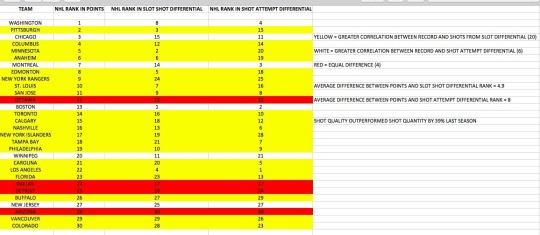
So just to recap: the argument, at least as I can understand it in the public sphere, is that shot quality is better than shot quality because of the above ranking system. He did this by coloring in rows for teams where rank variances were lower. He then took an average variance of the ranks, compared the two, and concluded shot quality was better. He lastly claimed that “shot quality was 39% better than shot volume”, which I think he calculated by simply netting the average rank variances and dividing out. (More on this later.)
You can sort of start to see the problems here.
For starters, it’s not clear to me why he would provide ranks rather than numbers, especially for a correlative analysis. Among other things, we want to understand sensitivity and variances. The above table would treat all team talent differences as equivalent. WSH is x amount better than Pittsburgh, Pittsburgh is x amount better than Chicago -- all the way down to Colorado. All we have are pure ranks and nothing else. There’s no good reason to run any analysis, ever, off of a ranking system like this.
But in fairness, it is plausible or even likely that he can’t release the percentages because his company owns it. Let’s assume this is a legitimate and fair constraint, and he -- in good faith, of course -- is trying to educate people on why this other measure matters.
Putting that aside, another slew of question should come up. What game state are we talking about here for slot and shot differential? I would suspect it’s not all situations because he would know that you shouldn’t be lumping unique game states (e.g 5-on-5 vs. 5-on-3 power-plays) as the same. But it can’t be purely 5-on-5 either. I know this because, well, 5-on-5 shot differential data is available.
I would also hope that he didn’t use raw 5-on-5 numbers, since we know the impact of score effects. Not only do trailing teams rack up shot differentials relative to their leading counterparts, they hurt their own individual shot quality in the process. This, again, is a known quantity -- it’s precisely the reason why we 'adjust’ Corsi% based on event, score, and venue.
Those numbers though -- they weren’t used in this ranking system. I quickly ran the table variances and, well, there are many. Amusingly enough, when you bring in *actual* shot differential numbers, there is no clear indication that either metric is better. One was more predictive for 14 teams. The other for another 14 teams. 2 remained the same.

The three right columns are what you’d want to look at. The 'Shot Rank Error H/(L)’ column is how variant Kelly’s numbers are to, well, their actual rank. Notice how Carolina is 13 ranks off -- that’s because there was no adjustment for score effects. Why the spread? Easy. The Hurricanes chased a ton of games last year, which, as everyone at this point knows, means that Corsi% goes up and Sh% goes down. This phenomenon was acknowledged and accepted back when the only hockey analytics studies were being done in the comments section of the Oilogosphere.
But I can’t just say 14 teams vs. 14 teams and call it a draw. That’d be lazy! And in fact, that’s not what he did. He took the average of each individual variance, ran quick division, and concluded that shot quality was 39% better.
So I’ll do the same. The average shot quality variance was 4.9. The average shot quantity variance was 4.5. Therefore, shot quantity is 8% better.
Same exact study. With the right numbers. And the completely opposite conclusion.
------------------------------------------------------------------------------------------
For the (quick) purpose of showing you why the above was wrong, I simply cleaned up Kelly’s work and re-calculated. But any credible analyst can see what’s wrong with this. And while Kelly may not be able to create this work himself due to employer constraints, it shouldn’t stop anyone else from asking these questions.
Let’s just walk through a quick list. I’ll give myself only two minutes to come up with pertinent questions ... starting now.
1. What game states are we measuring? 2. Why are we using a ranking system vs. the actual performance numbers? 3. How is ‘slot quality’ defined? 4. Why are we measuring to points, which is inclusive of performance across all game states, the overtime format, and the shootout format? 5. Why wouldn’t we consider a blended measure as a competing metric, like Expected Goal%? 6. Why wouldn’t we look over multiple season to increase our pool of data? 7. Why aren’t we adjusting for score effects? 8. Why are we taking the averages of rank variances to determine measurement superiority? 9. What’s our error margin? 10. How are we controlling for arena bias? 11. Why does ‘slot shot differential’ bin shot data? Does a shot one millimeter to the right or left of the slot have an expected goal value of 0.0? (No.) 12. Why are we correlating ranks?
And time. That’s 12. I’m sure you can think of more.
------------------------------------------------------------------------------------------
Just to recap: I think shot quantity matters. I also think shot quality matters. I think shot quantity matters more because it’s proven to be extremely indicative of a team’s true talent. I think when the data is aggregated together on an expected goal basis, the measures become even more robust.
But stuff like this bothers me. Tremendously so. If it’s not disingenuous, it’s bad faith. And if it’s neither, then it’s unacceptable negligence.
Keep in mind that NHL teams today are facing the same exact issue. Who do you believe? Who do you trust? Some teams have went with private data exclusively. Most teams, in fact. But some of those teams are just ingesting the data -- they have hired publicly-vetted, credible analysts to utilize that data to run complex analyses and make difficult decisions.
I don’t think you need to be vetted in the public sphere to ‘check out’ as a stat-based hockey analyst. Far from it! But it sure is interesting that some teams -- when faced with the question of ‘do you want our data or do you want our ‘services’? -- have chosen the former.
Those teams are worried about getting pushed down the wrong path. And they can’t risk being wrong, because their jobs are on the line.
My recommendation: treat everything like a skeptic until proven otherwise. (Second recommendation: feel free to change your opinion on things! It’s OK to be wrong.) This space was started, funny enough, because I was sure that SAP was taking the NHL for a ride. I have never been able to figure out if the NHL.com stats rollout was pure monorail sales work by SAP, sheer vetting incompetence by the NHL, or a combination of the two.
At the end of the day, SAP and the NHL took a terribly inaccurate product out of stage and into production. And although they have cleaned up some of the data discrepancies, the public is pretty uniform of it’s hatred of the current stats site. So much so that, well, not a single soul that I know or have worked with in the stats sphere for close to a decade utilizes it with any frequency.
If a company the size of the NHL can get taken for a ride, anyone can.
3 notes
·
View notes
Text
The NHL and Mass Appeal
I’ve been thinking a lot about the present/future of sports broadcasting, especially so in the last 24-hours. There’s been a lot of debate and discussion about how to improve these broadcasts, how to appeal to a wide demographic of viewers, and really, how to keep eyes on the television.
I do think the nature of the industry presents unique challenges – challenges that aren’t easily answered through quick fixes or the procurement of new talent.
I think it’s important to note though that the NHL is somewhat on an island here. I know this because Inside the NBA, for just one example, won it’s billionth Sports Emmy.
The Inside the NBA example is a great one because I think it captures the essence of what most sports viewers want. Two criteria: entertain me, and teach me something. Subjectively viewers might have varying preferences over which is more important but to a man or woman, I think everyone wants a piece of both.
Inside the NBA is much more entertaining than educational, but it’s not lost on me when Kenny The Jet is running over to the big-screen to break down a series of half-court sets that have thrown an opponent for a loop, or Ernie Johnson throwing around a well-thought out question that forces both the panel and the viewers to think.
Hockey in both countries is sort of in this weird spot where one (or both) of these pieces is missing. It seems as though every 5-10 minute segment is chock full of cliche after cliche after cliche. I can’t think of the last time I genuinely learned something from a national broadcast (though I will point out that some local broadcasts do a great job of instructional stuff during intermissions; LA and Dallas are two great examples).
I, obviously, would prefer to be educated than entertained. But if you can give me the latter, no doubt I’m sticking around. The problem is that hasn’t ever been delivered either. I know this because ratings across the board are in the tank and, nine times out of ten, the only thing mentioned digitally regarding a hockey broadcast is pointing out the newest and lamest one-liner that’s been easily debunked by anyone with dial-up internet access.
There’s a large part of this where I’m truly sympathetic and understanding to the decision makers on these broadcasts. I imagine it’s incredibly difficult to maneuver through all of this and, truthfully, I don’t even have the expertise to opine on a lot of this stuff.
But I do know that purely as a fan of the sport, there are frustrating examples of really talented, really smart people being placed in secondary or tertiary roles, their skill set being wasted for the newest slapstick they think will keep viewers tuned in. (Not totally unrelated from this week’s news, but it’s infuriating that Jeff Marek hasn’t been given one of the biggest roles for his company – the guy knows the sport inside and out and does an exceptional job at mediating things, not dissimilar to the aforementioned Johnson with TNT.)
The other truly grating things on hockey broadcasts – and with zero hesitation, I say hockey broadcasts as opposed to sports broadcasts; there is an order of magnitude difference here – is when completely junk analysis is passed off. I subscribe to the theory that it’s one of two things: outright laziness, or someone pressured into deriving some thought and cramming it into a tight window due to time constraints. Either way, it’s so painfully intellectually dishonest that it doesn’t matter the demographic of viewers – all should be equally insulted that people presumably paid significant amounts of money to fact check and generally know this sort of stuff are on-air passing off hot air as something that’s been vetted through subject expertise.
Make no mistake, some of this stuff is directly correlated to the struggles of the growth of the sport relative to something like basketball. Maybe it’s small peanuts compared to sheer relative expenses to get kids and teenagers into playing programs, but I’ve always thought that the easiest way to get someone to tie into a sport is to expose him to what it’s like at the highest professional level. The NFL is plagued with problems across the board but they have done an excellent job at captivating a young audience here. Ditto NBA. Ditto even the BPL, which has really made in-roads with NBC in the last few years.
Again, this is purely fan-speak with little industry expertise to rely upon, but I’d like to think I watch an inordinate amount of the sport across all platforms. Very rarely am I informed or entertained, and I sense that I’m not the only fan who feels that way.
In those instances where I am? Well, I make sure to mention it. To the point of exhaustion sometimes too, as anyone who follows my work knows. Play-by-play guys like Dave Strader and Ralph Strangis (why did you leave us?) and John Forslund and Chris Cuthbert, color guys like Mike Johnston and Daryl Reaugh, crossover panel types like Elliotte Friedman and Big Game Bob McKenzie – these guys are just unbelievably skilled and deserve repetitive praise. I’m forgetting a bunch of course but I think it’s important to really draw distinctions to what I (or we, or anyone!) prefer in my hockey broadcast just as much as what I don’t. It’s the only way I think the consumer can effect change, and I do think that matters to everyone in the industry.
9 notes
·
View notes
Text
In re: Concussion Litigation 2/4/2016
The NHL recently filed a Motion to Stay Further Discovery (pending the result of their Motion to Dismiss based on labor law preemption). The Concussion Complainants filed their Opposition today. And it’s pretty strong work.
Upload here: https://www.wetransfer.com/downloads/82c17c5cdfbe85030e778419d6cf238e20160204164451/d8a3afc600af24c5fa6aab29391999a020160204164451/96893b
0 notes
Text
In re: National Hockey League Players’ Concussion Injury Litigation
On the Hockey PDOCast last week, I mentioned that if anyone wanted to read through all of the pleadings and motion work in the pending concussion lawsuit against the NHL, I’d gladly share my document drive. I also urged people to start paying attention to what’s being alleged here, and how the NHL’s responding -- this suit is going to get really messy in the coming months, and I suspect it’s going to look quite poor on the league. (Just last week, it was ordered the unsealing of Colin Campbell’s e-mails.)
I was inundated with requests over the weekend, so rather than sending a hundred e-mails, I uploaded the entire drive to WeTransfer. The files start at 01 and 01-1 (The Complaint and Civil Cover Sheet) right up through 32 ( Order re: Motion to Compel, which I would suggest is mandatory reading at this point) The download link can be found here: http://bit.ly/1PwpAsW
I’ll try to update periodically.
0 notes
Text
SAP, NHL, and The Long Con
SAP and the NHL entered into a massive joint partnership in Q1 2015. The plan was for SAP to ‘revolutionize the hockey stats world’. Let’s check in with how they have done so far:
1. NHL’s stats database currently suggests that seventeen regular goaltenders have not given up a goal on the penalty kill (This is because they have inverted special teams save percentage.) 2. NHL’s stats database currently features completely inaccurate/randomly generated numbers for team-level shot statistics. They have been compared to multiple independent resources (all of which are agreeable on what the numbers should be). Not in the same universe.

3. NHL’s stats database has either inverted the faceoff count or is calculating zone starts through, again, randomly generated numbers. (Also true for certain players at the individual level.)

4. SAP has convinced the NHL that they can deliver results in less than zero seconds:

5. It is believed that SAP is going to (inexplicably) need three years time to digitize the NHL’s old stat sheets.
6. One of their biggest ‘rollouts’ to date was automated data viz, which includes user-friendly graphs like the following:
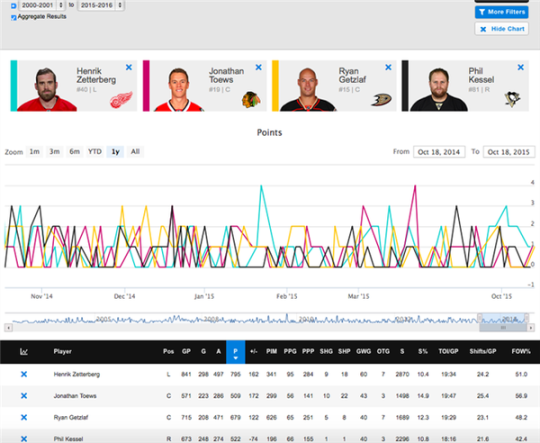
7a. The capturing and incorporation of "clutch factor” measurements, paragraph below, which almost certainly do not exist (but certainly sound nice!)
7b. As an extension of that, the belief that faceoffs are so crucial in the determination of outcomes despite all evidence to the contrary.

8. The usage of ‘close’ statistics (as a way to mitigate score effects) despite them being phased out years ago in favor of score-adjusted metrics.
9. The creation of a ‘milestone tracker’ to capture huge accomplishments for active players such as ... Chris Pronger.

10. “Deep statistical comparisons” which include little more than basic counting statistics that have existed for decades.
11. The searching of a database coordinator with proficiency in ... Powerpoint.
12. A relationship grounded in the belief that SAP would deliver ‘never before seen ideas’, which includes re-hashing of years old data that lives (accurately!) on no less than a dozen sites across the internet. As an aside, it’s somewhat amazing the NHL had so much tunnel vision over the last decade that they genuinely believe some of the furnished metrics are property of SAP.
13. Speaking of those never before seen ideas, check out these unprecedented (and stolen) shift charts!

14. Randomly generated CorsiClose% numbers. CorsiClose% is a defunct metric and has been for quite some time. Even if CorsiClose% wasn’t defunct, the numbers are still wrong:
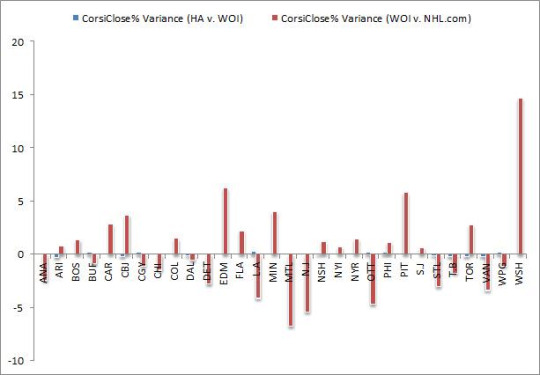
15. Their belief that what the market wants is ‘black box power rankings’, which was a key component of their ‘Phase Three’ rollout:

16. Totally inaccurate or randomly generated goaltending numbers with no source data from an old presentation:
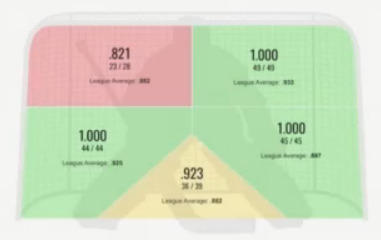
17a. A comical, comical belief that they had built a predictive model that could accurately select 85% of post-season winners. A reliable source indicated that this is one area the NHL pushed back on in disbelief. SAP eventually purged any mention of it from their publications without clarification as to whhy.
17b. (We checked the model anyway. I stopped caring once they couldn’t clear 50%.)
18. Has their snake oil sales act and falsified data had a negative impact? Well, hockey media still cite their numbers, despite the fact that (a) their database is inundated with inaccuracies; and (b) their business model seems to be little more than pulling doing a dance and pulling wool over the eyes of Big NHL. The dangers of being perceived as credible despite no supporting evidence, I suspect.
19a. What do NHL employees think about the product? Here’s Andrew Thomas, consultant to the Minnesota Wild: “ ..What burns me the most isn't at all "competition": it's extremely lazy work masquerading as professional innovation.”
19b. A league employee: “Up there with the first Lindros trade and the 1988 game with linesmen in yellow practice jerseys, only worse because the league would have us believe it is now competent.”
19c. Another league employee: “Outrageously bad.”
20. At the time of the first (and second) rollouts, NHL.com failed to separate game states from one another. I say this without hesitation: the separation of hockey statistics by game state is the FIRST STEP in hockey analysis.
In summary: there is no reason to go to NHL.com for anything related to hockey statistics. Their numbers are inaccurate. If not inaccurate, they are misleading. If not inaccurate or misleading, they aren’t capturing what they believe they are capturing. If none of the above, the site is a total hassle to maneuver through and the filtering/visualization looks like a child slapped the cursor on MS Paint a hundred times.
The NHL, at an early point in their business relationship with SAP, considered a liaison or oversight position to ensure that SAP’s deliverables were accurate. That never materialized. SAP’s ran roughshod since then. Many of the above numbers are data points pulled from months ago. These [inaccurate] numbers remain on the official web site of the NHL. There’s no quality control, no reliability, no incentive for SAP to satisfy their half of the partnership.
Why? Because at some point in time, the NHL realized that pushing the stats responsibilities out to a third-party meant a lot of man hours and headaches saved. They took no interest in vetting the information. And they ate up a ridiculous SAP song-and-dance about a litany of never-seen-before statistics that have existed in the foremost corners of the internet for close to a decade.
The NHL should terminate their partnership and find someone who actually cares about the work they are doing. And the SAP should find more big business to sink their teeth into before the well dries up. Monorail sales have never been better.
Lastly: if you ever want to conduct stats research, the following resources are worth your time.
Behindthenet.ca War-on-ice.com Hockeyanalysis.com Nicetimeonice.com HockeyStats.Ca TSN.Ca (Naturally.)
48 notes
·
View notes